#Where to eat in Leyte
Explore tagged Tumblr posts
Text
Forever Cafe Isabel: A Cozy Oasis in the Heart of Isabel

View On WordPress
#Cafe in Isabel#Cafe in Isabel Leyte#Forever Cafe Isabel Leyte#Organic Food in Leyte#Philippines#Philippines Beautiful Destinations#Restaurant in Leyte#Salad in Leyte#Seafood Restaurant in Isabel Leyte#Seafood Restaurant in Leyte#shakaz seafood and grill#Tourist Attraction in Isabel#Tourist Attractions in Leyte#Tourist Destination in Leyte#Tourist Spot in Isabel Leyte#tourist spot in Leyte#Tourist spots in Leyte#What to do in Isabel#what to do in Leyte#Where to eat in Leyte
0 notes
Text
What's up homies!!!? How's college life? Kaya paba? Kung kaya nira, kung kaya ko, kaya mo liwat!.
This activity indeed open an opportunity for me to introduce myself because for some reason I felt that am left behind, being an irreg student sucks huhu.
To begin with, let me acquaint all of you. Hi! I am 𝐂𝐲𝐫𝐚 but you can call me 𝑺𝒂𝒚𝒔𝒂𝒚, 21 years stunner. A 4th yr student taking up Bachelor of Arts in Communication under the advisory class of ma'am Chelo aka master Jopay. A senior student who looks like a freshman or sophomore because of my height, cute size though, lol.


Story Time ✓
Dyk? of course you don't HAHAHA kidding aside. Being a BACOM student wasn't in my plan at the first place. My childhood dream is to be become an educator, and yes I pursue it but in just a span of 2 s.y (1st-2nd yr) because of some horrific reason I shifted course/program. Almighty God has changed my path, he brought me into BACommunity and I believe that this is the right way for me to achieve success. Even though I didn't get the course I wanted, I'm happy with what I'm taking now. I already love my course, I'm embracing it's essence and the people involve.

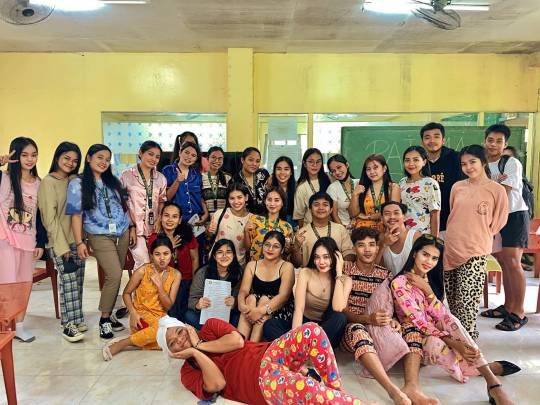
Here's the uninterested things about me;
✓ I do love cooking, I can cook, just drop what dishes you want I'ma cook it for you, keme HAHAHA
✓ Loves to read books, acads/wattpad related.
✓ Music is my therapy, and also I'm a huge fan of Taylor #swiftie
✓ I am fascinated and mesmerized by the sight of sunset. Sunset always reminds me that an ending can be beautiful too.
✓ I'm a moonchild, l like moon so much. It's my therapy too, if I'm going to be baptized again I'm beyond grateful to choose Luna as my name.
✓ Family oriented and tatay's girl ♥️ I can conquer everything just for them. They're my inspiration, weakness and strength.
✓ Hobby? if eating is a hobby then I'll count it on HAHA ems, the truth is I'm into poems, I do write too (kapag may motivation). I have some works on my journal skl. I do write story too, in my watty account though I feel it like a 'basura' and conyo.
All about my hometown
This photo is the animated version of St. James the Greater Parish church. (ctto)

Taft is one of the ancient pueblos in Samar situated in the Eastern coast which was called Tubabao or Tubabaw in early times. This town was originally named after the river called Malinaw, but since the river causes heavy floods during rainy season, people began calling the place Tubig, which means water in Waray-Waray. Taft has 24 barangays
#BungtohanTubig

Have you heard about Dangkalan Pacific Beach Resort of Taft? if you haven't then take a look on how beautiful the scenery was. Way back in highschool life of mine, me together with my circle of friends used to go in here. We didn't pay for the entrance because we went through the back, by the sea HAHAHA this resort definitely go beyond your expectations, perfectly beautiful (sayang diko na ma post yung pictures, max of 10 pics lang pala dito).
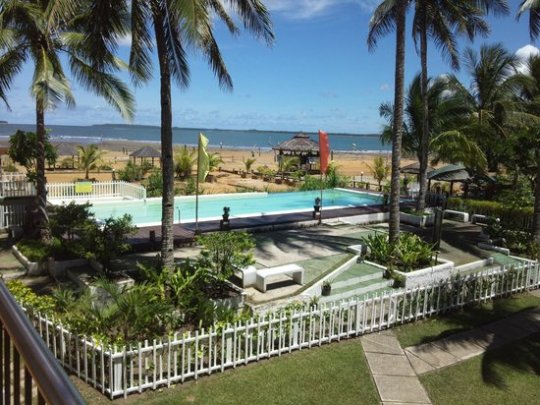
Also, Taft has a hydropower plant energy. The project uses of the running water in Taft-Tubig river to secure affordable power in the Samar-Leyte area. It consists of three units with 5.9 MW each.
“Hydro projects are challenging to build but despite the pandemic [the company] did it in record time of less than two years,” Taft Hydro Energy President Benjie Q. Picardo said in a statement.
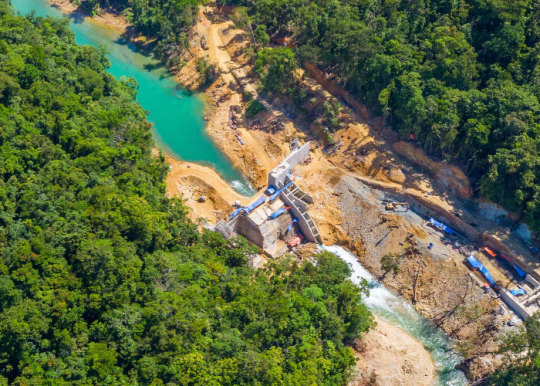
And now, I'm loud and proud to shared the barangay that I love despite of having a lot of marites, this is the place where I born, grow up and reside, Brgy. Mabuhay, Taft, E. Samar (insert mini miss u music)
Not to brag but my great grandfather was the first barangay captain. He also donated land to build a school, so our barangay had an elementary school.
#MabuhayElementarySchool

So, this is my first entry. Thank you so much for lending your precious time reading and taking a look at my blog, Mabuhay ka hangga't gusto mo. Smile sweetie, it suits you. Khob khun Kha!!!
2 notes
·
View notes
Text
went to tagaytay all by myself 🏃♀️
My! First! Ever! Solo! Travel!
I have traveled solo before, when I would go to Leyte to see my family, but never like this where I had no company at all.
As I have mentioned before, our trip to Quezon inspired me to do this. And I did it for many reasons such as my bucket list, to learn to enjoy my own company, to fix my dependence on friends to be happy (to fix my loneliness), a little getaway before life gets serious, and also partly a spiritual journey.

Sobrang kinikilig ako. Haha. Kung weird man kiligin sa sarili husgahan niyo na lang ako pero ang saya niya sa feeling. Pagdating ko sa airbnb nagtatatalon ako sa tuwa 😭 Tangina gano'n lang pala. Bakit dati ang imposible?
My agenda for this overnight trip was: Staycation, Eat at a restaurant, Skyranch, and Picnic Grove – I can't do tight itineraries yet. I like to think I could just come back to try out the places I haven't visited or experience things like the horseback riding, boat riding, and the zip-line again as an adult. But for now, I'm just trying to be comfortable being alone in such a setting.
I arrived at the airbnb around 5pm, then I settled for a bit before going to Skyranch. When I got to Skyranch, there was a suddenly a fireworks display – nag-abala pa talaga sila sa pa-welcome – so I took selfies with it. Then I roamed around, bought souvenirs, and I ate at Mama Lou's! Which was my first time splurging on food (I was surprised when I saw the prices but, oh, well, no one's there to judge me), and boy was it so good. I don't know if it's my basic taste buds but the Truffle Pasta was life-changing. After I ate, I sang at a karaoke room, and then I rode the Sky Eye. I also wanted to ride the rollercoaster but I'd be the only one in line coz there was only a few people around.

When I got back to the airbnb I was gonna have a movie night, just watching sad girl movies, but I only finished one because I was already tired from the trip, the walking, and I had no energy left.
Then here comes a new day. I stayed at the airbnb until it was time to checkout. Para masulit ko naman yung place. I loved the unit, really. It was cozy, comforting, and vibey. It was a small studio unit, very aesthetic, and it was just perfect for me.


I remember there were a few comments, reactions, from the guards and drivers I interacted with, about me not bringing someone. I didn't know what to tell them. Hinahanap ko po kasi sarili ko? Hahahaha. Alam ko mga kuya mas masaya 'pag may kasama. Alam na alam ko 'yan. Pero kailangan ko po kasing maging okay na walang kasama, that's the point.
My friend asked me anong gagawin ko sa Tagaytay mag-isa and I said, wala, emote emote. So that's what I did.
Hidden agenda ko rin na iiwan ko na kasi doon si Carson but that's all I'm gonna say about that.


It's partly a spiritual journey because, believe it or not, I had the courage to book this in the first place because I knew I was with God. I was alone but He was there with me. For once, I didn't think it'll be boring or sad not to have my friends around. I wasn't afraid about being alone. I was, in fact, determined about being alone. And I'm just so, so grateful for Him for everything.
Tagaytay, I'll be back! I loved it there. Bulalo is one of my most-craved food since forever. I love the breeze, the people, the view. 🩵
0 notes
Text
The Unique Eagles of the Philippines: Majestic Raptors of the Archipelago
The Philippines, an archipelago of over 7,000 islands, is home to a diverse range of wildlife. Among its most iconic and awe-inspiring inhabitants are its eagles—particularly the Philippine Eagle, which stands out as one of the most unique and endangered eagles in the world. Eagles are often seen as symbols of power, freedom, and resilience, and the eagles of the Philippines are no exception. Here, we'll dive into what makes these birds so special and the efforts being made to protect them.
The Philippine Eagle: The King of Philippine Raptors

The Philippine Eagle (*Pithecophaga jefferyi*), also known as the "Monkey-Eating Eagle" ,is the most famous of the Philippine eagles and perhaps the most unique. It is not only the "national bird" of the Philippines, but also one of the largest and rarest eagles in the world.
Physical Characteristics
Standing at around 3 feet tall with a wingspan that can reach 7 feet, the Philippine Eagle is an imposing bird. Its striking appearance includes a crown of brown and white feathers, a large, hooked beak, and piercing blue eyes. The feathers on its head often form a distinctive crest, giving it a regal and fierce look. The eagle’s powerful talons are designed to grasp and tear through prey with ease, making it one of the top predators in the Philippine forests.
Habitat and Diet
The Philippine Eagle resides in the tropical rainforests of four major Philippine islands: Luzon, Leyte, Samar, and Mindanao. Due to deforestation, their habitats have dwindled, leaving them critically endangered. They prefer dense forests where they can hunt for food, which primarily includes small mammals, birds, and reptiles. Despite its name, the "Monkey-Eating Eagle," it does not exclusively feed on monkeys. Their diet is diverse and adaptable, often depending on the available prey in their territory.
Other Eagles of the Philippines
While the Philippine Eagle garners most of the attention, the country is also home to other fascinating eagle species, such as:
The Crested Serpent Eagle (*Spilornis cheela*)

The Crested Serpent Eagle is known for its distinctive call and its preference for hunting reptiles, particularly snakes. It can be found across Southeast Asia, but the subspecies found in the Philippines, *Spilornis cheela holospilus*, is a unique variant. This bird is smaller than the Philippine Eagle, with a dark brown body, a yellow face, and a short crest.
Unlike the Philippine Eagle, the Crested Serpent Eagle thrives in a variety of habitats, from lowland forests to more open areas, making it less vulnerable to habitat loss. Its adaptability has allowed it to maintain stable populations in contrast to its more endangered cousin.
The Pinsker's Hawk-Eagle (*Nisaetus pinskeri*)

Another raptor endemic to the Philippines is Pinsker’s Hawk-Eagle, also known as the Mindanao Hawk-Eagle. This bird is smaller than the Philippine Eagle but shares similar habitats, preferring the dense forests of Mindanao and nearby islands. Its striking plumage, with a mix of brown, white, and black, along with its swift flight and agility, makes it a formidable hunter of small mammals and birds.
Pinsker's Hawk-Eagle, like the Philippine Eagle, is also classified as endangered due to habitat loss and hunting. However, it receives less attention and conservation efforts compared to the national bird.
Conservation Efforts: Saving the Eagles of the Philippines
The Philippine Eagle Foundation (PEF) plays a crucial role in the conservation of these majestic birds, particularly the Philippine Eagle. Established in the 1980s, the foundation focuses on habitat preservation, captive breeding, and community education programs. Breeding these eagles in captivity is challenging due to their slow reproductive rates—they only lay one egg every two years, and raising a chick to adulthood takes considerable time and resources.
Other conservation groups work to protect smaller eagle species like the Crested Serpent Eagle and Pinsker's Hawk-Eagle, but much of the focus remains on the Philippine Eagle, which has come to symbolize the country’s broader struggle to conserve its unique biodiversity.
Government efforts and international collaborations are also key, with environmental laws aimed at protecting endangered species and their habitats. However, illegal logging, mining, and urbanization continue to threaten the forests these eagles call home.
Why Protecting Eagles Matters
The eagles of the Philippines are not just top predators; they are keystone species in their ecosystems. By maintaining a healthy eagle population, the entire forest ecosystem benefits. These raptors control populations of smaller animals, preventing overgrazing and maintaining the balance of flora and fauna. When we lose eagles, we also risk losing the biodiversity of the forests they inhabit.
Moreover, eagles are culturally significant to many indigenous groups in the Philippines. For these communities, eagles symbolize freedom, courage, and spiritual power. The loss of these birds would not only represent an environmental tragedy but a cultural one as well.
Conclusion: A Symbol of Hope and Survival
The eagles of the Philippines, particularly the Philippine Eagle, are enduring symbols of the country's natural beauty and ecological richness. However, they are also reminders of the environmental challenges the country faces. Through conservation efforts, public education, and a commitment to preserving their habitats, there is hope that future generations will continue to witness these majestic eagles soaring through the Philippine skies. Protecting these raptors is not just about saving a species—it’s about preserving the natural heritage of the Philippines for generations to come.
1 note
·
View note
Text
Beyond the Beaten Path...
Traveling is something that people enjoy. Something like watching the sun go up and down. How the sea splashes on your body and how the sand touches your feet. It is the feeling of refreshment. This is how I experienced it while traveling along Samar Leyte.
Guian, Eastern Samar is my father's hometown. We do not often go to Samar due to a lack of money. But when we go home, we enjoy it until our body goes down. It was fun until it ended. The feeling of meeting new people, experiencing different kinds of cultures and languages, and also trying different kinds of foods.
It has been six years since our family went to Samar. I still remember how we traveled. We used a bus and a ship to get there. We do not have enough money to purchase a seat on an airplane. We endured the hours and also the day traveling from Quezon City to Eastern Samar. It is a tiring journey but a new experience, indeed.
It has been six years since our family went to Samar. I still remember how we traveled. We used a bus and a ship to get there. We do not have enough money to purchase a seat on an airplane. We endured the hours and also the day traveling from Quezon City to Eastern Samar. It is a tiring journey but a new experience, indeed.
When my feet touch the ground after a few hours of traveling, I still can't believe that we're now in the hometown of our father. The peaceful air, wide roads, a bunch of trees, and also the small but beautiful houses feel so unreal compared to the cities here in Quezon City.
We rested for a few days before going to different places. Our first destination was the church. We rode a tricycle that drove us for a one-hour trip before we arrived at the church. It was huge and also beautiful.
Our family decided to have a reunion. This is where the fun started. We decided to reunite with everyone at the beach. Where the white sand and the blue sky greeted my eyes.
We can't go home without taking pictures of the scenery, so my cousins and I walked around the beach to take pictures. We were full of laughter until the sun went down. We didn't get the chance to take a dip because of the rising sun.
My other relatives called us to get something to eat. We were having a big fight. We have a variety of foods like tilapia, hotdogs, eggs, tuyo, and many more. We also eat different kinds of fruits and drink refreshing refreshments like buko.
After that, my cousins played volleyball while I took pictures of the scenery. It's so fun to watch them. I love how they splash the sand onto one another. The way their smiles reached their eyes I love all of them.
As I said, it was fun until it lasted. It was a breathtaking experience. I didn't notice how fast the weeks began to end. I just realized that it's now the end when we're on the ship going back to Quezon City.
It was a really joyful ride! Despite traveling for a long time, I still got to enjoy different kinds of things. Regardless of how the years passed until now, I still remember the feeling of being in that kind of place.
0 notes
Photo

Pag-asa, the late Philippine Eagle
Pag-asa is best known for being the first Philippine Eagle bred and hatched in captivity. He remains an icon of biological heritage conservation upon hatching in January 15, 1992.
The Philippine Eagle is a giant bird of prey that can only be seen in 4 islands in the Philippines – Luzon, Samar, Leyte and Mindanao. It is considered to be one of the largest and most powerful among forest raptors. —Philippine Eagle Foundation

Image from the website of the Philippine Eagle Foundation.
The Philippine Eagle was discovered in 1896. Before it was known as its common name by virtue of Proclamation No. 615, it was dubbed the “monkey-eating eagle” after the bird was alleged to prey on monkeys.
The Philippine Eagle (Pithecophaga jefferyi) seems interesting in its own way. Its eaglets are fluffy—fluffballs that appear to least reflect the fact that it will grow to a large bird of prey. But even as an adult, it exhibits a graceful coat of browns.

Image from Reddit.
Philippine eagle pairs remain loyal to one another; they are monogamous. They lay a single egg for every two years, and a pair will alternate in incubation for 58 to 68 days. A couple will not lay another egg unless their offspring is able to fend for itself.

Image of Pag-asa as an eaglet from the Philippine Eagle Foundation via PanahonTV. This was the reference pic I used!
The namesake of Hope may have soared beyond its physical home, but he has passed on this legacy. His only offspring Mabuhay and many other captive-bred eagles carry on this little triumph.
Hopefully, we can build hope in various spaces, where one of these will be the co-existence of humans and nature and conservation of creatures unique in our areas.
15 notes
·
View notes
Text
Bike Touring the Philippines
Bobby Lagsa
For most of his life, Melchizedek "Merky" Aranas Garcia have been dreaming of traveling the entire Philippines-each of the 81 provinces, there is. His dream came true in 2019 when he biked around the country for the first time.
Merky is just one of the growing numbers of Filipinos who are taking the extreme length to pedal their ways around the country, exploring places most Filipinos can only dream of.

On February 24, 2021, Merky, along with fellow adventure bikers, Romeo Llante of Cavite and Valeri de Guzman of Baguio City started their journey to bike tour the archipelago all the way to Davao City where Merkey lives.
Garcia is a seafarer by profession and when he arrived in the country following a 14-months work onboard, he planned that he will bike his way home to Davao City.
Like Garcia, Llante is an engineer working in the Middle East for almost 10 years while de Guzman is a social entrepreneur.

This is not the first time for the trio to bike their way around the Philippines. Garcia did his first in 2019 right after getting off the ship. Llante also did an extended bike tour in 2019, spending six months on the road alone. de Guzman is also a veteran long-distance biker.
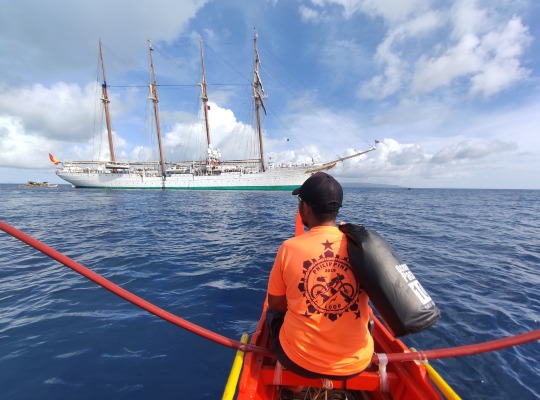
They left San Pedro, Laguna on the 24th of February, and for the next 45 days, they would pedal their way to Southern Luzon, Visayas, and Mindanao.
Garcia said that bike touring is an entirely different approach than just doing the Philippine Loop. “With bike touring, your aim is to tour the country rather than just passing by, doing the Maharlika Route all the way to Mindanao and taking the RORO (Roll-on, Roll-Off) ship to cross the island,” Garcia said.
"The goal is to tour, not just speed your way around the country, without even stopping to enjoy the destinations," Garcia said.
“When I was growing up, I dream of biking my way around Mindanao. When I had my apprenticeship on board, I saw how beautiful the Philippines is,” Garcia said.
Garcia added that back then, he had no money and thought of just biking his way to get to places.
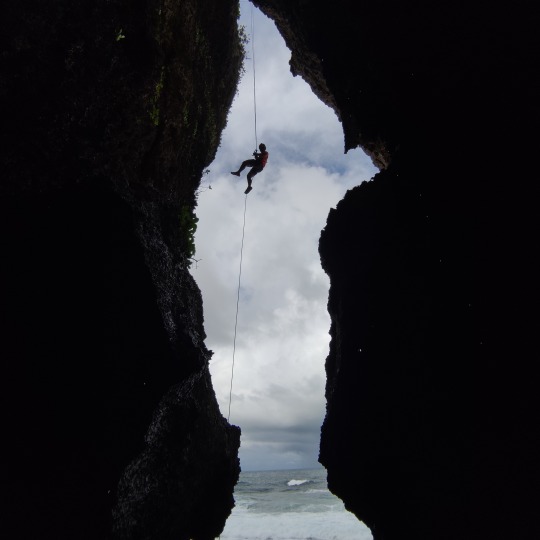
For Llante, it was an outlet to get away from the hustle of life in Cavite and from working overseas for an extended period.
OPEN TIME, OPEN BUDGET
What open time, open budget means is that they have no formal plans of what route they are going to take. “Anytime we can change our plan, we can change our route, we can change how long we are going to stay in a place,” Garcia said.
The trio agreed to their plan. They can spend as much time on the road as they can. They passed by countless tourism destinations during their 45 days on the road.

“I wanted to climb mountains,” Llante said. In his 2019 tour, he climbed 11 mountains including Mount Apo, Kitanglad in Bukidnon, Hibok-hibok in Camiguin Island.
They have crossed muddy road, climbed mountain roads just to get out-of-the-way waterfalls, rivers, and communities they wanted to explore.
“Our longest stay was in Samar, where we spent 2 weeks exploring the two provinces,” Garcia said.
They camped out in Huplag Adventure Camp in Bantayan Cliff, Ando Island, Borongan City where they get to experience sleeping on a hanging hammock with a 150 meters drop to the seas.

“We waited for the replica of Magellan’s ship the Juan Sebastián Elcano to arrive in Guiuan, Eastern Samar,” Llante said.
When the El Cano arrived in Homonhon Island, they rented an outrigger to get closer to the ship. “Sadly, we were not allowed to go on board because of Covid protocols,” Llante said.
After the El Cano crossing, they spend the next 2 days in Homonhon and Suluan Islands before heading back to the mainland and off their way to Leyte.
Along with their ways, they were met by fellow bikers who are only too eager to host them. “Sometimes, I informed friends who I met during the 2019 tour that I am passing by,” Garcia said.
“Sometimes, when they met us, they would bike with us to destinations, and when we get there, foods are already prepared for us,” Garcia said.
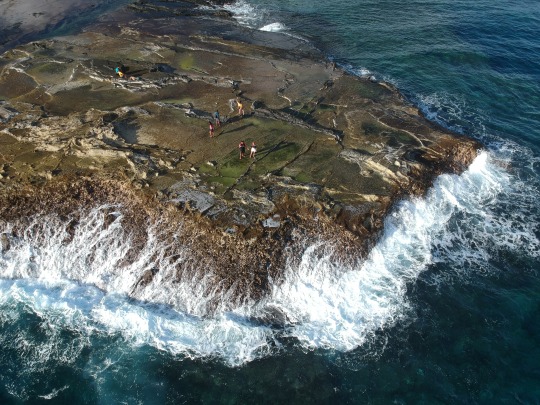
The trio, along with other bike clubs that hosted them, also held community engagement programs like feeding and giving school supplies for children.
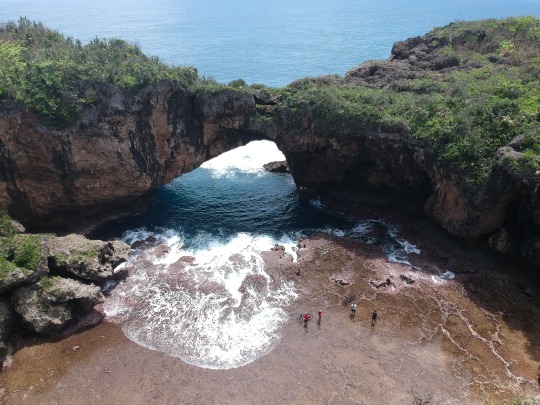
LOGISTICS, PREPARATIONS
Biking for an extended period of time can be a difficult task and it takes determination and courage just to conquer steep climbs and muddy roads to get to their next destinations.
“Before I arrived from my work onboard, I already planned my bike tour, told some of my friends I’m doing a bike tour again,” Garcia said.
Garcia wanted to invite friends so that it will be more fun. “It is more fun to share the road with friends who share the same passion as you are,” Garcia said.
Llante and de Guzman rise to the challenge of Garcia.
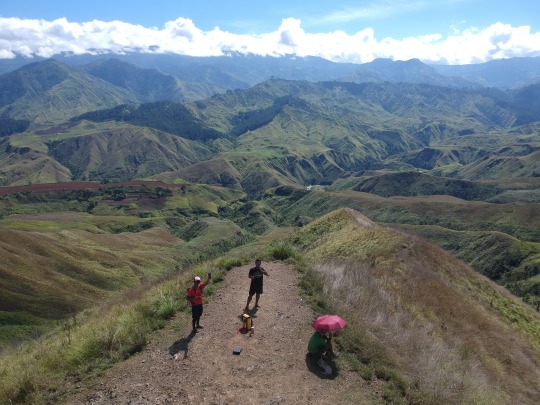
“My bag only consisted of 3 short pants, shirts,” Garcia said. On his backpack, he carries his drone that would prove to be very useful in getting dramatic, scenic shots.
“You only need to bring light materials, all our clothing are quick-dry,” Llante said.
Their daily budget is only 500 pesos per person per day, except for destinations that they would need to spend more, 500 was their daily budget which include foods, hotels, drinks.
"On the road, you need to eat well and hydrate well," Llante said.
“The plan really is to set-up tents by sunset,” Garcia said.
“We would sleep in barangay halls, beaches, gasoline stations, roads with trees we can hang our hammocks,” Llante added.

But mostly, Filipinos welcomed them to their homes, offering sleeping spaces. Experiencing the hospitality of the Filipino people was a humbling experience. "We are strangers and yet they welcome us, provide us shelter and food as we share our stories with them," Garcia said.
“When there is nowhere else to sleep, we would pay entrance fees to resorts and just camp on the beach,” Llante added.
There were days also that they do really need to take a good sleep to recover physically and had to spend nights in resorts or inns. “We need to rest, but hotels are our last resort,” Garcia said.
They also agreed never to travel during nighttime, except for one instance during the first few days of the tour. after pedaling for almost 18 hours, they arrived in Naga City around 11 pm raking in almost 200 kilometers.
“We agreed to pedal only during daylight, where sunset catches us up, we would set up camp for the night, we are not in a hurry anyway,” Garcia said.
200 kilometers is the most the pedaled in a single day, after that, their average is just about 80 kilometers per day.
There are times that they would need to rest at noon for an extended time as the heat of the sun becomes almost unbearable. “We rest where we wanted to, we don’t plan of getting to this town or that town, we stop at sunset,” Garcia said.
When they arrived in Davao City where Garcia is from, de Guzman had to make her way to Cagayan de Oro and left the two. De Guzman could be in Cebu as of this writing, doing her Cebu loop on and on her way to Negros Island.
THE PHILIPPINES IS A BEAUTIFUL COUNTRY
Garcia and Llante eventually pedaled their way to this city, spending two days along Sayre Highway, exploring Bukidnon. They arrived here on May 1 and spent 4 days here exploring and meeting with fellow Philippine Bike tour loopers.
Words on the biking community here were that de Guzman was met by an all-female bikers group and was given a warm welcome.
Bike touring the Philippines was a humbling experience for Garcia and Llante. They have pedaled almost 3 thousand kilometers and visited most provinces along the Maharlika Highway.
Garcia’s count crossed out 63 out of 81 provinces since he started his bike tour in 2019. Llante crossed out 11 mountains, and almost visited each province in the Philippines.
They have seen most of Filipinos can only dream of- touring the entire Philippines, learning cultures and traditions, meeting people, and experienced lgendary Filipino hospitality and conquering their own selves.
Garcia and Llante is a testament of achieving dreams even if it means just being armed with just bare necessities.
Garcia and Llante is now planning their next bike tour, hoping that more bikers would join them.
NOTE:
all photographs were provided by Merky Garcia
FOR THEIR 2021 Philippine Bike Tour, Garcia spent 35 thousand while Llante spent 50 thousand.
Since Valerie de Guzman was already in Cebu, she was not around for the interview.
#bike touring#bike touring philippines#philippines#philippine bike loop#biking#long distance biking#tourism#bike tourism#bike camping#merky garcia#romeo llante#bobby lagsa#manila to davao#luzon visayas mindanao#bike touring ph#travel#samar#ando islan#philippiines#mindanao#visaya
3 notes
·
View notes
Text
Desmond Thomas Doss

The Real Desmond Doss:

Desmond Thomas Doss was born on February 17, 1919 in Lynchburg, Virginia. He was the middle child of William Thomas and Bertha Oliver Doss. His older sister, Audrey, was born in 1916 and his younger brother, Harold,�� was born in 1922.
His mother was a Seventh-day Adventist, a Protestant Christian denomination, and she passed her beliefs onto her children, which included not working on Saturdays (the Sabbath) and not eating meat. Desmond was devoted to the Ten Commandments, of which “Thou Shall Not Kill” played a pivotal role in his life.
The film based on Desmond Doss and his bravery, Hacksaw Ridge, takes certain liberties with his childhood. But his father, like seen in the movie, had an alcohol problem. His heavy drinking led to a brawl with the youngest of the children, Harold, and almost ended in tragedy when his father pulled a gun on Harold. Luckily, his father did not fire the gun but the event still affected Desmond heavily.
After he completed one year of high school, he became a carpenter. He later worked at Newport News Shipyard as a ship joiner. Although this job would allow him to not enlist or be drafted, he decided it was his duty to enlist. He enlisted on April 1, 1942 and he was quickly sent to Camp Lee.
Desmond refused to carry arms. He was a conscientious objector. Which caused great unease and suspicion around him. There were many reasons for an army man to fear a CO. Some men claimed the status simply to avoid combat. They had to have religious reasons to be a CO and not simply a hatred of the war. Most of these COs trained like the rest of the men, but not pick up a gun or weapon. Many COs, like Desmond, became medics. There were 43,000 COs during World War II. 25,000 of them were medics/noncombatants.

He wouldn’t pick up a gun or fire one. He refused to carry a single weapon. He requested to become a medic instead. "I specifically requested medical duty," Doss said, "because I felt that while I could not kill, I could help save human life."
Much like the movie shows, Desmond and his fellow soldiers did not get along. His unit was the 77th Infantry, which consisted of older, New Yorkers. Desmond was a young, soft-spoken Virginia boy. These combinations did not mix fairly well. But Desmond’s status as a conscientious objector caused a lot more problems for him. His unit originally had 4 COs, but by the time they were sent overseas, only Desmond was left.
Desmond faced tremendous harassment. This came from his superiors, his officers, and his fellow enlisted men. They threw shoes at him during his nightly prayers, insulted him to his face, and one told Desmond that if he went into combat that the soldier would shoot Desmond.

His objection to carry a gun or train on Saturdays, the Sabbath, resulted in an effort to get him discharged from the Army. Those trying to remove him claimed he deserved to be removed under the section that declared “inaptness or undesirable habits or traits of character.” This was more fit for people with mental illnesses. People went so far to try to prove Desmond had a mental illness. Desmond defended his faith, saying it was not a mental illness.
They even went so far to try to court-martial him. Which is shown in the movie but it did not go as far as it did during the movie. In real life, it was only a threat. While he was later denied furloughs to see his wife and brother, Desmond didn’t miss his wedding day, he was already married by then.
In the fall of 1942, Desmond got married to Dorothy Schutte. They were married August 17, 1942 in Richmond, Virginia. They had met in church one day, when Dorothy was selling adventist books in his town. The movie shows she was a nurse and they met when Desmond went in after rescuing a boy in a car accident. This isn’t entirely accurate because she only got her nursing degree after the war.
Dorothy gave him a Bible that he carried throughout combat. When he lost it at Okinawa, his company put together a search to find it in the battlefield and they miraculously found it.

The movie fast forwards through time, ignoring combat at Guam and Leyte. Once the men hit combat, their perspectives of Desmond began to change. He was a damn good medic and the men began to put their trust in him. One such occasion was when Desmond found a man who’d been hit in the head and had blood rushing down his face. Desmond washed his face, clearing the man’s eyes of the mess and restoring the man’s sight. To which the man responded, “I can see, I can see. I thought I was blind.” This is instead moved to Okinawa in the movie.
In Leyte, Desmond lost a close friend. After his loss, he refused to look any at any of his patient’s faces, unless their face was the part wounded, in case they were a friend of his. He would treat the wounded without meeting their eyes.
Desmond earned the Bronze Star for his actions on Leyte. By the time he reached Okinawa, the men and replacements trusted him completely due to his skills as a combat medic. He was a valuable asset to morale within his regiment.
Desmond was not oblivious to the risks he was taking during combat. He was completely aware that he was risking his life to save the wounded men, but he repeatedly made that choice. Even when he wasn’t required to risk it or go on patrols, he continued to do so. There was only one time he rejected going on patrol. The patrol had left a while earlier, leaving Desmond behind. When he was ordered to go on patrol, to go catch up, Desmond refused to go. He explained to the man in command that Japanese could have come up behind the patrol and he would charge into them. He also explained that these replacements were skittishly new and were very likely to accidentally fire on him.

The Maeda Escarpment was a ridge, that rose 400 feet high, with a vertical, jagged cliff that led up to the hiding Japanese troops. This is known as Hacksaw Ridge. Before the soldiers led the challenge of a thirty-fifty foot jagged cliff the American troops would have to climb before they could even start their fight.
For nine days, the American troops fought the Japanese for the ridge. Not much land was gained, whenever the Americans gained a bit, the Japanese overwhelmed them and threw them back. This carried on, back and forth.
Doss, ever faithful to his beliefs, did not hold a weapon throughout the battle. He passed one box of grenades forward, after much debate, but did not touch anything with the intent to harm.
But his true acts of heroics and self sacrifice happened from April 29-May 21, 1945. He served as a medic with his company. When under heavy fire he refused to fall back or hide and instead, risking his own life, carried the wounded men back to the edge of the 400 foot ridge one-by-one to the bottom with rope. “When the survivors gathered at the bottom of the cliff, they noted a wounded man on a stretcher being lowered down the escarpment. Looking up, they saw Doss maneuvering the stretcher, but Doss quickly realized that a stretcher was hard to handle alone without endangering the wounded, so he remembered a training exercise where he had accidently converted a bowline into large double loops of rope. The loops would not slip and would serve perfectly for securing the legs of a wounded man. Doss took the running end of the rope and passed it around the wounded man’s chest and secured it with another bow- line knot. He carefully slid the man over the cliff edge and then lowered him using the friction of the line around a tree to steady him,” claims Booton Herndon, in the article The Unlikeliest Hero: The Story of Desmond T. Doss, Conscientious Objector Who Won His Nation’s Highest Military Honor.(Mountain View: Pacific Press, 1967.)
He lowered 75 men down off of the Ridge. Doss argued that he had only saved 50 men. The men always believed he’d lowered closer to 100. So they compromised on 75.

On May 2, he risked his life under fire again, rescuing a wounded man 200 yards forward of the lines. Two days later, he treated four men who had been wounded, advancing through a shower of grenades, where he tended to them, and made four separate trips under fire to return them to safety.
On May 5, The final assault to take the Maeda Escarpment happened on the morning of the Saturday, the Sabbath. Doss held on to the Sabbath as a day of prayer, being the only Medic left in his company, he agreed to go but requested that he first be given time to read his Bible. The delay was approved and the the assault was put on hold until Desmond finished his devotions. May 5, he suffered under enemy shelling and gun fire to assist an artillery officer. He applied bandages, moved his patient to a spot that offered slight more safety, under artillery and mortar fire, he admitted Ed plasma. Later that day, Later that day, when an American was severely wounded, Doss crawled to him where he had fallen 25 feet from the enemy position, tended to his injuries, and carried him 100 yards to safety while continually exposed to enemy fire.
The company suffered enormous amounts of casualities. They had started this battle with 800 men, when they finished fighting, they had 324 men.
May 21, during a night attack on high ground, when everyone else took cover, Doss refused and aided to the injured men. This exposed him to the risk of being exposed not only to enemy fire but also friendly fire, in case he was mistaken as a Japanese soldier and shot on the spot.

He was severely wounded in his legs that night by a grenade. He tended to his own injuries, rather than risk another medic’s life. He waited 5 hours for a stretcher to reach him. When he was being carried back, he was caught in Japanese tank attack. Doss noticed another man more severely wounded, a severe head wounded, than he was and he crawled off his stretcher. He directed them to tend to the other man, and to leave him until they could return to him. At one point, 17 pieces of shrapnel were in him.
He was once again wounded. His left arm suffered a compound fracture due to a sniper. Desperate, Doss turned to the gun for the first time. But only to use the stock as a makeshift splint for his arm. He then crawled 300 yards in rough land to an aid station.
He was evacuated May 21, 1945. On the hospital ship back, he realized that the Bible his wife Dorothy had given him had been lost in the battlefield. He had carried it throughout combat with him. Doss’ company searched for it. As a way to honor him, even thought they had once wanted him gone. Surprisingly, they found it. General Bruce himself came to visit Doss during his recovery. During his recovery, he was promoted to Corporal and learned he was to be awarded the Medal of Honor - the first conscientious objector to be awarded such an honor

On October 12, 1945, Desmond Thomas Doss was awarded the Medal of Honor by President Truman.
The war had ended, and Doss was to be discharged. But, an exam revealed he suffered from tuberculosis, which is believed he had gotten on Leyte. Eventually, he lost a lung and 5 ribs. He was was not released from the hospital until 1951. His son, Desmond “Tommy” Doss Jr. was born during his time in the hospital in 1946. Doss could not see his son due to the tuberculosis.
He continued to receive treatment for tuberculosis, but in 1976, he suffered an overdose of medicine that made him completely deaf. Dorothy began writing messages to him so they could communicate, jokingly calling herself his “hearing ear dog”. He would eventually regain some of his hearing in 1988, due to receiving a cochlear implant.
Dorothy and Desmond had only one child. Dorothy raises their son Tommy almost completely alone for the first five years of his life. After the war they lived out their years in Rising Fawn, Georgia on a small farm. Later in life, Dorothy developed breast cancer. She died on November 17, 1991, from injuries sustained in a car accident while Desmond and her were driving to a hospital, crashing less than a mile away from their house.
Desmond remarried in 1993 to Frances Duman in 1993. They were together until his death in 2006. He adopted her three children: Thomas Duman, Michael Duman, and Marilyn Shadduck.
Desmond, after being hospitalized due to trouble breathing, passed away in his home in Piedmont, Alabama in March 23, 2006. He was buried in the national cemetery at Chattanooga, Tennessee. Frances died 3 years later. The three are buried next to each other in the cemetery.
Doss’ legacy was captured in the movie Hacksaw Ridge, directed by Mel Gibson. Desmond is portrayed by Andrew Garfield. It won two Oscars, out of the 6 it was nominated for.

219 notes
·
View notes
Text
Mark & Georgia’s Big Trip
Chapter Seven – Miscellaneous Ramblings II
Another busy week, but that’s become the norm. At least this week we saw good progress towards getting everything together that we’ve been trying to get together. But not much of a theme so just some thoughts on the important events of the week.
Caretakers
The biggest milestone this week was that we selected and hired our housekeeper and caretaker. Plus their two boys – we will soon have a new family in our home, and we’re very excited. You’ll soon meet Ranny and Pina, and their boys Prince Denver and Ethan, who will take up residence in our caretaker’s apartment.
Ranny (pronounced “Ronny” – remember that the vowels AEIOU are pronounced here, without exception, Ah, Eh, Ee, Oh, Oo) for the previous seven years has worked as a groundskeeper for Kawayan Cove so he comes with excellent gardening and tree maintenance chops. Pina has been a homemaker, is a great cleaner and a good cook; Georgia says she’s a good student and will quickly learn our favorite dishes. She already knows that I like fresh fruit every morning – half the battle’s won already! Prince Denver (8 yrs) and Ethan (4 yrs) are just normal boys, though very polite. I think it’s going to be fun having them around.
Capiz
Capiz is both a province in the Philippines, on Panay Island, as well as an oyster from the area known for its special shell. A capiz oyster is on the left, the harvested and cleaned shell on the right. One shell of the oyster is flat, growing to 3-5 inches in diameter, and importantly, translucent.

You find all sorts of items here made from capiz – Christmas ornaments, outdoor lights, ashtrays, you name it. When we lived in the Bay Area, Georgia always said you could tell a Filipino’s house because of the capiz lights in the trees. Harvesting and producing craft items from the shells is today the principal livelihood of the people of Capiz. Historically, capiz is important in Philippines heritage and culture, one that’s given away by the Capiz oyster’s Western name: windowpane oyster. For thousands of years the shell served as the “glass” in Filipino windows; many older homes still feature these windows today.

So why this story about capiz? On this week’s trip to Manila, we were wandering around a mall and walked into an antique store. Stacked against the back wall we found a number of dusty old capiz windows. The shop owner had no hard information about their provenance but said they were likely from the 1800’s. They looked it; the Narra and Molave wood was weathered but the craftsmanship was still evident and not of this century. No nails or screws, the window frames are joined with hand-made mortise and tenons, held with wooden pegs. The capiz was dirty, but almost 100% intact – it looks fragile but is actually pretty sturdy stuff. We’re not sure yet what we’ll do with them, but we now have three panels. After an afternoon spent cleaning them we have a treasure we’ll proudly display.
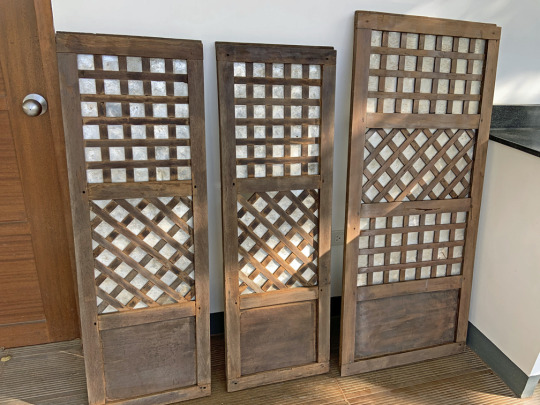
Calamansi
I don’t think Calamansi has been featured in my Strange Fruit of the Day series; it’s really not that strange anyway. Calamansi is the citrus fruit of the Philippines. About ¾ to one inch in size, they look a lot like a key lime but aren’t limes. The insides and juice are orange, but they’re not oranges. They aren’t lemons either, they’re just Calamansi. They flavor many Filipino dishes: you’ll typically squeeze one onto your Pancit before eating, or onto your grilled fish, and they’re often an ingredient in the dipping sauces served with many dishes.
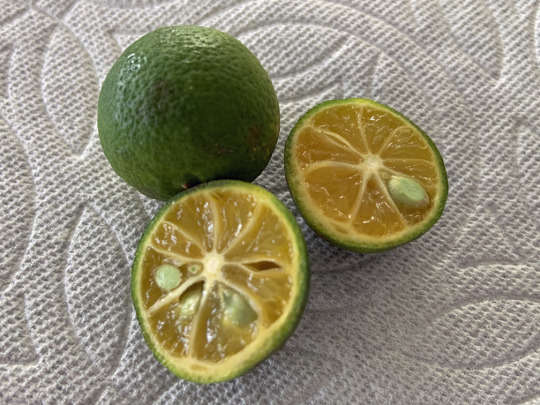
There are no limes here, so I had a dilemma: how to make a proper Gin and Tonic. Finding decent gin was easy (S&R/Costco), and after searching a few stores I found tonic water. But no limes. Calamansi to the rescue! I’m now able to enjoy my favorite summer cocktail. And it’s always summer here! Cheers!

The Massage Table
Massage is a way of life in the Philippines. Go to almost any beach and there will be massage tents set up, in the city there are plenty of establishments, or just call for home service. My only complaint, actually my neck’s complaint, is that the traditional Filipino massage is performed on a flat bed, not a massage table. You’ll sometimes find a real massage table but it’s rare. Fast forward to our weekly trip to S&R, and there it was! My neck had a sudden seizure as I tried to walk past, so into the cart it went! We set it up on the “meditation deck” and brought in a masseuse that Hervé and Lett turned us on to. She’s expensive, about $12 an hour, but good. Very good. Ahhhhhhhh, heaven!

Friends with Furniture
Our friends from Manila, Noel and Michelle Tanada, who have been mentioned before in my blogs (they’re the members at the Balesin Island Club with whom we’ve had some memorable trips) visited us yesterday. I don’t think I’ve ever said much about them. Michelle is a former local TV star/singer; after that career a serial entrepreneur, starting and running businesses in the advertising field. Noel was originally headed for a career in law, but left that world for his art, which encompasses traditional forms such as painting and sculpture, but his real passion lies with interior design and furniture design. In all they do they only use native and sustainable materials, or recycled materials, and always local labor. You can learn more and view some of their products at www.ecohomeart.com. They are also both active environmentalists, deeply involved with coral rehabilitation (www.coralmovement.org). This shot is with them at Balesin Island last year.

Today’s visit was more than a social call as they delivered a van full of furniture, some of the last items for our living room. We’d asked Noel to create some custom bar chairs, a breakfast table and chairs, and a credenza. Since we live in Kawayan Cove he chose a bamboo theme (kawayan is the Tagalog word for bamboo). He also brought a special floor lamp for us. All beautiful and unique pieces we’re proud to have.
House Tour
Finally all the major furniture is here and the house is feeling pretty livable (though we did fine with just a plastic card table and a mattress on the floor for the first 2 weeks…). So, I’ll wrap this up with a photo tour of our newly furnished rooms.
First up is the living room. The coffee and end tables from the acacia slab have arrived, we’re very happy with them and like the way they go with the sofa and love seat. The turtle on the coffee table is from Puerto Vallarta and has a special connection with Kawayan Cove – every fall Olive Ridley sea turtles arrive at Kawayan Cove to lay their eggs.
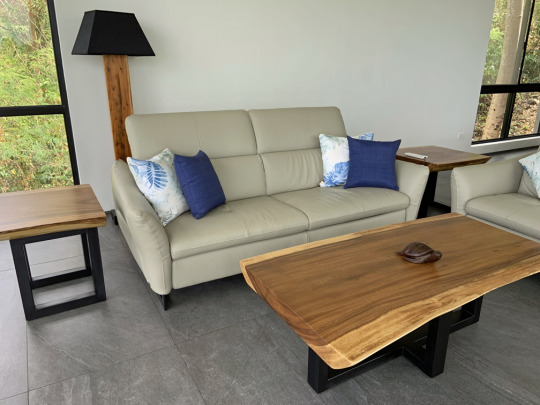
These are two of the barstools Noel designed for us. Using 100% native and sustainable materials, the backs feature split bamboo and the upholstery is hand-woven Tikog grass from Leyte. Besides a warm an inviting look, Tikog is durable and has a very nice, soft feel. It’s woven into many items here, historically the Banig which is the traditional Filipno sleeping mat.
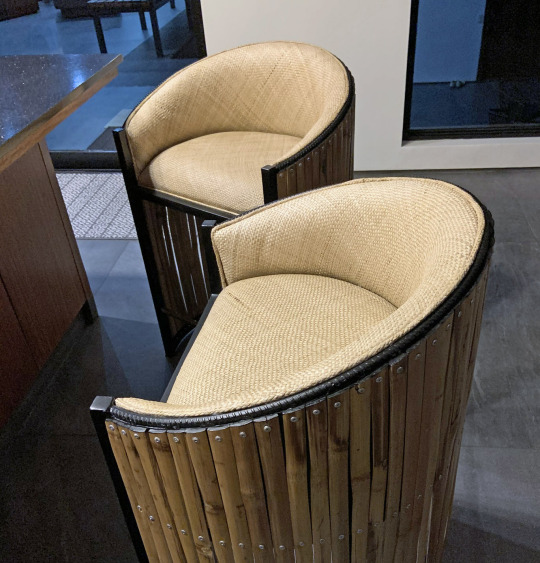
Also in the same style and materials are this breakfast table and chairs. Noel feels the table design is sexy, resembling a woman’s curves. You decide!

One of Noel’s more creative pieces is this dramatic floor lamp, reflected in our corner windows. The lamp is made of water hyacinth reeds. Beyond being a sustainable material, the use of water hyacinth has an additional benefit as it’s a nuisance here, growing quickly and clogging rivers and harbors.

New in our master bedroom is this computer desk, made of mahogany from our design by Boyet, one of the construction foremen for our contractor. Boyet also made all of the cabinets in the house.

Our small guest bedroom, the one with the great view, has two new side tables of acacia, which we picked up pre-made at the same place where we got our slab. Note the baskets on the wall, which made their way here from the White Sulphur Springs Ranch rummage sale!
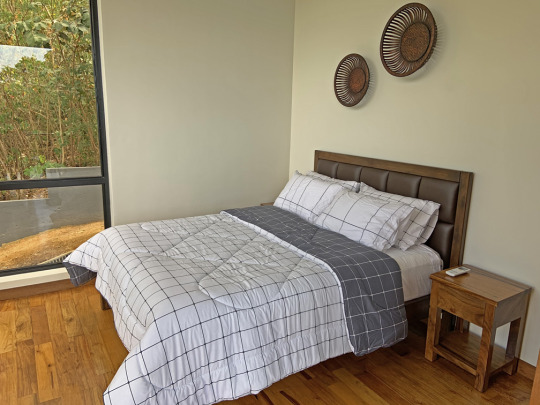
Last up is our second guest bedroom. In trade for the lack of a view you get a larger room, with a sofa and coffee table, which is the final piece of our acacia slab. Any of you who visited the Mokawk Community Resource Center last fall will recognize two paintings by Tyler Jacobsen, and a woven wall hanging by Salli Wise. Sorry the bed’s not made, we’ll make sure that’s done before you arrive!

1 note
·
View note
Text
Aephoria: A Dive into Ormoc City's Hottest Bar

View On WordPress
#aephoria#aephoria bar in ormoc#Bar in Ormoc#Leyte#Ormoc#Ormoc City#Philippines Beautiful Destinations#Things to Do in Ormoc City#Tourist Attractions#Tourist Attractions in Leyte#Tourist Destination in Leyte#tourist destinations in Ormoc#Tourist Spot#tourist spot in Leyte#Tourist Spots#Tourist spots in Leyte#Tourist Spots in Ormoc#what to do in Leyte#What to do in Ormoc#Where to eat in Leyte#where to eat in ormoc
0 notes
Text
Witness the Alangalang Hidden Secret
Alangalang, Leyte Philippines
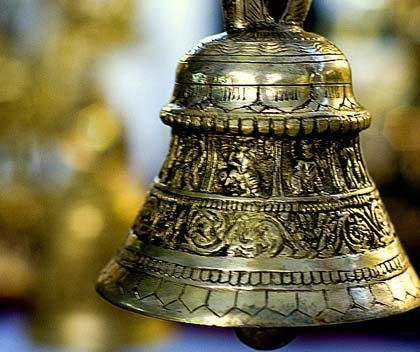
As proud Alangalangon, let me showcase to you the hidden secret of my hometown, the place where i conceived, where i first see the beauty of the world, where i grown up and becomes who i am today. As an Alangalanganon, it makes me proud that we are known because of our classic delicacies that suit to the preferences of today's generation, the beautiful and instagrammable rivers and places to visit. Additionally, if you are fond of shopping we also has a mall to offer.
To know more about my beloved hometown, let us first know the history behind Alangalang, Leyte.
History of Alangalang, Leyte
Lingganay is term familiar with cebuano or hiligaynon speaking people. but in many places, this is called “Campana”.
This church bells, played an important role in our identity, this serves as the instrument in communicating with our Alangalanganon. during those times of moro raids, coastal settlements in different part of the country, rang their bells, prompting its settlers to flee for safety in the hinterland. when the Moro flee in Leyte, they raided various towns including Alangalang. Intentionally came here in our town when they heard about tale of an extraordinary golden bell that can resonate a sound so strong that will be heard miles away.
one time, Moro pirates caught the people guarded the golden bell and then when they notice it they fled hastily with the bell. as they were closing the Bagka river they saw the Moro pirates following them. So, rather than surrendering the treasured bell of our town, they decided to dropped it into the deepest part of the river.
after the Moro pirates had been driven away, the people tried to get back the bell. until now, people of Alangalang remains hopeful that someday, they will get it and back it lively sound.
Beautiful Spots to visit
The Most Holy Trinity Parish
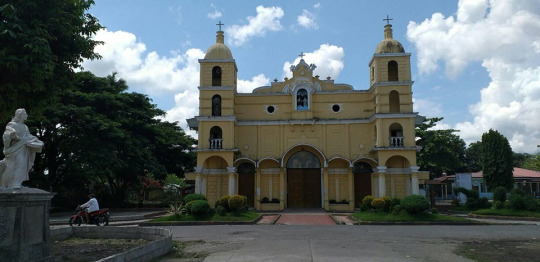
If your searching for serenity and peace, which is good for meditation and prayer i suggest to visit our parish, the Most Holy Trinity Parish.
Our parish is located in Brgy. San Antonio Poblacion near town plaza. One thing that makes our church peculiar to others is that its structure is a cross- like shape. You will appreciate this at the top view of it. To be honest, i didn't notice this before until i notice it in our calendar that has a image of our church. This is a place were you can express your true self by voicing out all your problems as well as your achievements to Him.
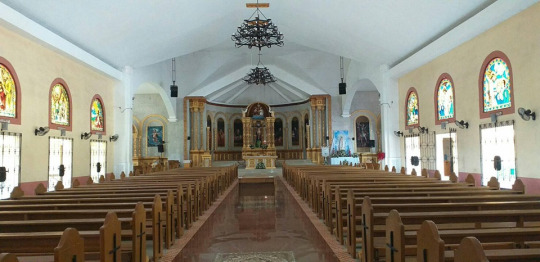
Inside the church you will see six saints that has an important contribution in spreading the gospel of the Lord centered by the golden tabernacle.
In the upper corners of the church walls, you will see the 14 station of cross that signifies the suffering of Jesus up to its resurrection.
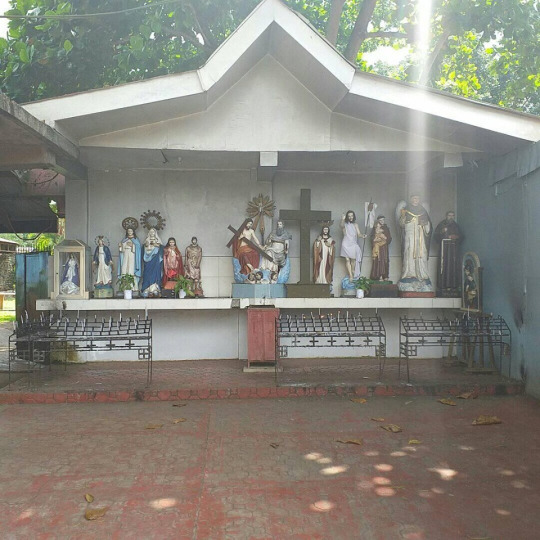
If you wants to light candles and offer a prayer to God, you can visit the adoration chapel found inside the church ground. From this moment, i remember the days that my friends are i light candles and have some prayers altogether. How i wish to be back in this memorable moment of my life.
Municipality of Alangalang, Leyte
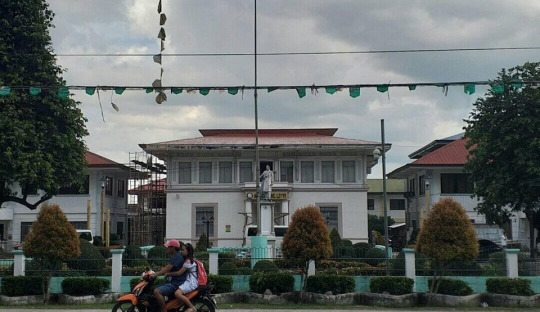
Our municipal hall is located at Real Street Brgy. St. Nino. The structure at the center is quiet old, but the others were new. Inside the municipal , specifically in the area along Mayor's office you will see the different mayors of my town.
Outside the municipal hall, there's a monument of Dr. Jose Rizal erected which represents that Alangalangaon gives respect to our national hero and cherish all the sacrifices done by him.
Town Plaza

The plaza is located nearby the Most Holy Trinity Parish. This place has an especial part in every lives of Alangalanganon. It witness how people of Alangalang develop and grown up, even in times of ups and downs. That's why if you feel tired, dark and weary or even stress with your works in school or in workplaces try visit Alangalang town plaza and enjoy. There are many things you can enjoy like seesaws, money bar, slides and swings and experience childhood again. There are always people staying here with their friends and boyfriend/girlfriend especially high school students to chill out and enjoy after the stressful works in school. If you feel hungry, don’t worry about it because their's a lot of street foods procurable within the plaza like kwek kwek, isaw, buko juice, fishball, lomi, barbeque and balot.
Briss River
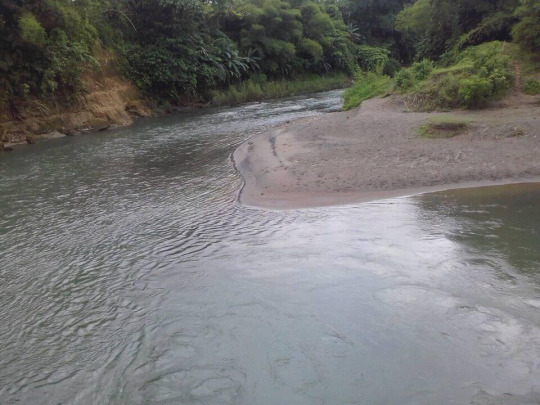
This river is located at Brgy. Hubang Alangalang, Leyte. There are always visitors coming here every vacation like the last summer, there are a lot of visitant came here just to visit the cold fresh greenly water and its pure sand. Other says that this is a Boracay version of our locality. I am proud to say that this is located where i am currently living, actually i grown up here. We, my childhood friends, my cousins and i always swim here when we were a child but sadly now that we are young adult already, we just go there to wash clothes. But, i am happy that there are always people visiting our very own briss river. Now, that semestral break is approaching i'm so excited to swim here.
Delicacies of Alangalang, Leyte
Filipino loves eating. We likes to eat a variety of food. It became part of our lives. Indeed, our day will not be completed without these exquisite Filipino food. But, sometimes food becomes boring as we prevalently consume it. Thus, sometimes we should try something that's not we usually eat. Let's try to have a taste of various foods meticulously prepared by our locals of each provinces that are all comfy in taste.
Do you feel the boredom of the foods present in your locality? Do feel discontented with things offered to you by your place? Wanna try a new place where you can cultivate freshly experience you haven't gone through before? Why not try Alangalang, Leyte and be a CPA?
If you were in Leyte specifically in eastern part or anywhere in the country, try to visit Alangalang, Leyte. My very own town, Alangalang, Leyte have a lot to offer. Alanglang boasts their own kakanin that symbolizes the richness and and closeness of my beloved town- Alanglang, Leyte.
Whether you're craving for something with coconut milk or with rice flour, coconut meat, bananas or even root crops, Alangalang has it all for you. Listed below are the most popular native delicacies of my town you should crave for, make sure to have a bite of these before you leave Alangalang, Leyte.
Puto

This is a round cupcakes like kakanin made from rice flour mixed with coconut milk and sugar. They are steamed for almost an hour and topped with sliced cheese. This kakanin is usually sells during market day also known as "tabo". This is usually packed containing 6 pieces for only Php 5. Actually, why i like this delicacy is not just its affordable price but the taste itself. You can savor the aromatic fragrance of a vanilla syrup and the "anis" which gives additional flavor of this kakanin. During tabo day I also asked my mom to buy this whenever she is going to the market. Another thing you shouldn't miss about this is that puto is best paired with the classic Dinuguan. If you want try this classic puto. You can visit Alangalang Public Market, specifically during Tuesday and Friday (Tabo Day).
Kutsinta
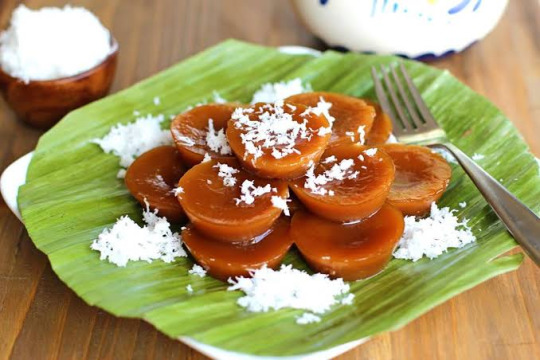
It is similarly with puto, the differences only is its texture and color. Kutsinta is a brown cupcake like kakanin that can be seen also alongside with the puto vendor but usually they are present in the same stall. This kakanin are made from flour, sugar, annatto powder and lye water. It's best to eat with grated coconut that gives additional flavor of milkiness to the kakanin. Same with puto it is sold 6 pieces for Php 5 as well. Before, way back 2018, their is someone who sell this kakanin in our barangay through his pedicab. What i like to his kakanin is you can buy it by means of rice, 1 canned of rice ( salmon in our dialect) is equivalent to 10 pieces of kutsinta. Sadly, i didn't see him anymore, maybe he have another route to sell his gelatin-like kutsinta. But, if i saw him again i will surely by a lot.
Biko
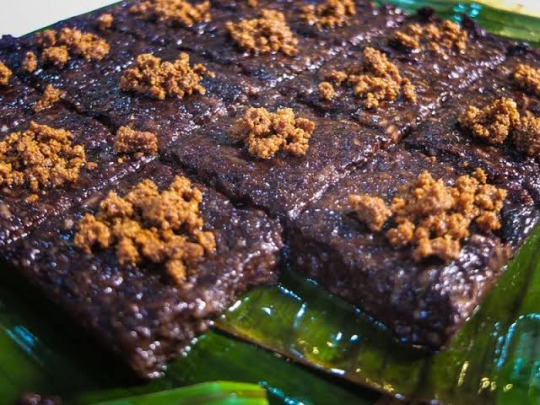
Biko is basically rice cakes topped with latik. Latik is a crunchy and sweet stuff made from caramelized coconut milk and sugar. This kakanin is rarely seen in the market because it is usually not for sale. Biko is quiet big on birthday, fiesta, christmas and even new year as they are served as dessert. This kakanin is usually seen after harvesting period of rice. A slice of biko would surely go well with a cup of coffee or perhaps tea. Its great to eat at any time of the day. However, too much eating of this delicacies may lead to inappetence. That's why if you want to eat biko make sure that you can consummate all you have served. In addition, this month of October is a period of harvesting rice. Thus, we are fortunate because we can have a taste this seasonal kakanin. Be sure that you will try this before the stock last.
Turon

Turon is delicacy made from ripe banana called "saba" dipped in caramelized sugar and rolled in a spring roll wrapper then fried. Saba banana is in medium size yet chubbier compare with other bananas This snack taste sweet, crunchy and satisfying. I know guys that we're all familiar with this because we typically made it at home because we have a lot of bananas here in Alangalang, Leyte. This kakanin is mostly patronized by students. I can proved it because im one of them. During my senior high school days, after our classes my friends and i usually go to the stalls behind Jollibee selling turon, banana cue, and kamote cue to buy some. Also, before we go to Church to pray we often passed by to that stalls because this where found near the church. Why is that this snack is being loved by students, simply because its very affordable, you can taste this as low as Php 5 only. I am not shock if students opt to buy this. Eating this is best when you were with your friends.
Sarongsong

If you were not contented with the puto and biko. If you were craving for more rice-made delicacies, Alangalang has one more to offer. What is it? It' s sarongsong. This delicacy is similarly with puto, both were made of powdered- milled glutinous rice cooked in coconut milk and brown sugar over a steamer. Unlike puto, sarongsong uses banana leaf shaped into a cone. Consequently, the banana leaf gives an additional aroma to the kakanin. In my family tradition, we usually make this in a special celebration like Christmas and new year. Also, when someone of our relatives is going to Manila. Thus, i am so excited for Christmas and taste my Lola's special sarongsong.
And now you already know the hidden secret of my beloved hometown, what are you waiting for visit Alangalang, Leyte with your friends or even with your girlfriend/ boyfriend and have a momentous time with one another.
1 note
·
View note
Text
a touch of education

Charmyn Gene Pantin Acala is my name. I am a girl who was born in Javier Leyte, on 31st October 1991, the second daughter of three children namely Crystal the oldest and Cheryl our youngest. My father's name is Higino Maballo Acala, who just passed away last June 23, 2020 and my mother's name is Elsa Arribas Pantin an OFW in Athens, Greece. Since both my parents worked abroad at that time, we were taken good care of my grandparents who are both elementary teachers namely Butch V. Padagdag an EPP teacher as well as a library custodian and Beatrice Mabalo Acala-Padagdag a Home Economics teacher. I started my study in Baptist, and finished my kindergarten in Angelicum. My Elementary years, started in Javier Central School from grades 1-4 and then transferred to B.V. Closa until I graduated.
My life in high school started in East Visayan Adventist Academy (EVAA), but wasn't able to finish because it was hard for me to stay in a new place and I feel aloof. I was transferred to Javier National Highschool in the middle of the school year.
The next year, I started living in the city of Tacloban together with my sisters, under the care of Msgr. Bernie Pantin who happened to be a parish priest at that time before he was assigned to a new place. While we are in the city, our lives changed. We used to go to the church and spent time with the priest who acted as our second fathers. Every time the church conducted some celebration I and my younger sister are always invited. So, I boost my self-confidence and it started with singing which I love the most. Hang out with some new faces in the church, traveling in and outside the city, and eating together with the priests, we had this feeling of attachment to the church as well as the people inside.
My mama, rented an apartment for us to stay in while we are in the city. As a result, I was transferred again to Holy Infant College until I graduated. Living away from our parents lead us into responsible ladies. I was awarded as a quiz bee champion in our school, I had also experienced being a cartoonist, and had given the chance to join the contest for the battle of the brains where I earned the silver medal in the said school.
In pursuing higher studies, I enrolled myself in System Technology Institute in (STI) Tacloban, I chose Computer Science at first believing that I can make a robot of my own. But this didn't happen because I shifted to a Diploma of Office Skills and Management (DOSM). I had experience being a receptionist in Pag-ibig Fund during our On-the-Job Training or OJT. Time flies by so fast, and I landed a job with the help of my father at the Municipality of Javier, under the Department of Agriculture headed by Mr. Raul De Paz.
After years of working, I had a baby. Now it’s already two baby boys. Then I felt like there's a need for me to address the call for teaching. So, I decided to enroll in the year 2019, in Bachelor of Secondary Education with a major in English. Now, I am already in my third year of college.
Life is a matter of choice and challenge; you might have found a happy life but there's always something that haunting you back that needs to be address.
1 note
·
View note
Text
How Social Media has helped families, social workers, and government in discerning information during calamities?
Social media is a computer based technology where most of the informations are being shared online. In 21st Century, social media is famous, most of the people know what it is and how it works. Many lives are being saved because of social media. For example, in the Philippines typhoon Yolanda killed thousands of people in Leyte and other parts of Visayas, most of the survivors starve and they can’t find any food or something to eat. When the information was shared on many social media platforms, many people helped the survivors and donated foods to them, some people made fundraisings to help Yolanda survivors. Although other media platforms like TV, Radio, and Print can spread informations, social media is so fast to spread and many people can reach it anytime or anywhere.
1 note
·
View note
Text
SA SAMAR
May 4-8, 2018 - ”Nasaan na raw po ‘yung mga paintings ni daddy?” (Where are my daddy’s paintings?)
The lack of Waray words in the sentence might’ve encouraged my grandmothers to ignore my inquiry once again. Still, I insist—I cannot let down my dad’s excitement and mine, too. It was my first time in Samar, and right after setting my foot in the tiny Tacloban airport, I knew it was going to be a special experience. It must have been different for them, though. I am just their (literally) distant granddaughter who visited the province for the first time as a representative of my dad, the young man who left his hometown in his 20s and hasn’t come back since.

Western Samar, 2018
I traveled to Samar for a 5-day vacation with my two Waray Balikbayan aunties. What they spoke of 60% of the time, I have no clue! Upon landing at Tacloban, we immediately embarked on a 5-hour drive from the airport to my grandmother’s humble home. I’m all groggy and tired, but I can’t waste those 5 hours of stories and beautiful scenery by sleeping.
My aunts hired a local driver and they exchanged short anecdotes on the life of Yolanda survivors after the great Typhoon, the freshness of seafood and vegetables in Samar, the perfect places to buy pasalubongs, etc. I struggle to keep myself in the conversation, asking them to translate in Tagalog a sentence or two.
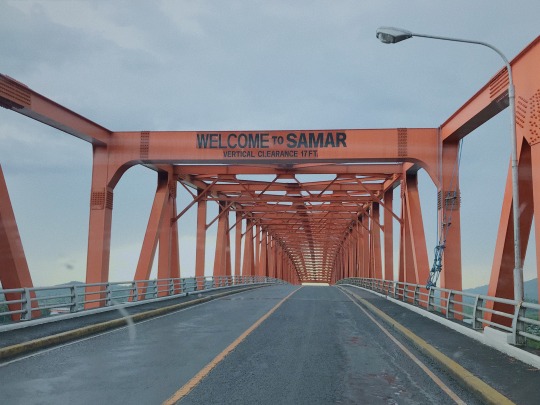
San Juanico Bridge, 2018
The ride started from souvenir shops, gasoline stations, and small parks, to tall palm trees, an overlooking of the shore, and of course, the Samar-Leyte connection—San Juanico Bridge—and its good-looking view. Serene and beautiful. Not until we noticed the recurring view of identical half-made houses that seemed to be under construction AND abandoned. They were the pabahay (housing) for the victims of Typhoon Yolanda.
Our local driver narrated the current situation of the pabahays. It is a worry that most of the houses can comfortably accommodate only at most 3 people. But, it is even more problematic that most of them currently accommodate less than they can—none��because they are not even halfway done. See, Typhoon Yolanda happened almost 5 years ago.
On a positive note, it is a relief to know that there are housings of good quality provided mostly by the NGOs and other donors. They are medium-sized, beautifully-painted, and some are even equipped with a satellite dish. :)
SAN PEDRO
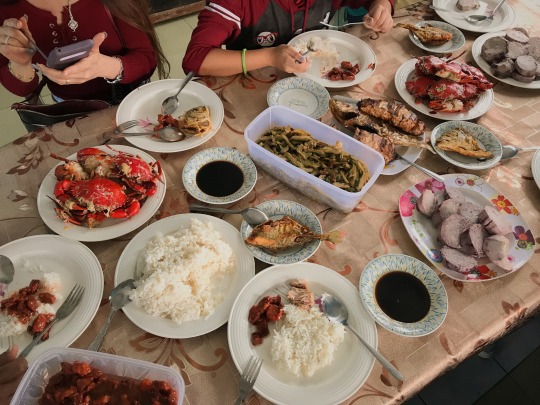
San Pedro, Quinapondan, Eastern Samar, 2018
My grandmother and Aunt Baby, the sweetest of them all, welcomed us with a big hug and a feast of seafood, vegetables, root crops, and meat. Freshness beyond words. We ate together with our hands, and called to meal whosoever happens to pass by the dining area. It was a feast! I can still remember how my hungry, jet-lagged self devoured that meal. Jollibee is no match. Sobrang sarap talaga huhu
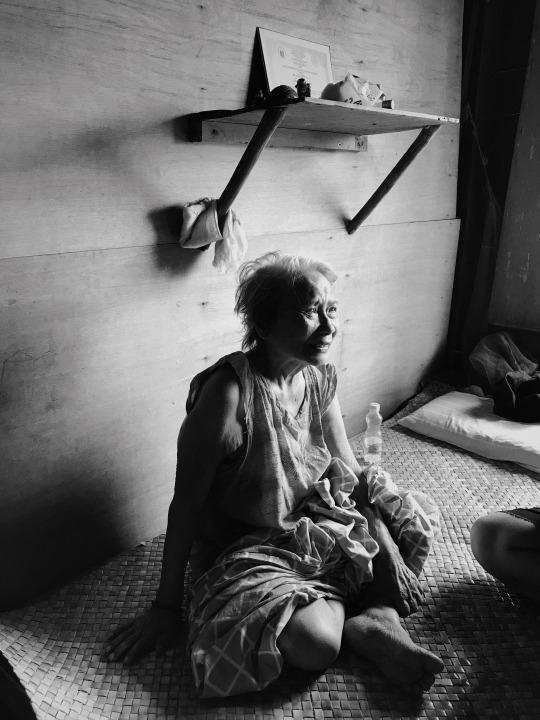
San Pedro, Quinapondan, Eastern Samar, 2018
A mini "welcome tour" from my Aunt Baby followed afterward. Meeting my cousins that day was like meeting them for the first time. We were kids when we last spent time together. My cousins smiled shyly and said nothing as my Aunt Baby called them from their rooms. If their eldest sister--who was of my age--was there, it might have been different.
My Aunt Baby's eldest son tagged along as she led me to the shabby stairs of a bahay kubo across my grandmother's house. The bahay kubo was old and fully furnished, but spacious. It housed relatives I've never met until then: my father’s cousins, their children, and their blind mother—one of my grandmothers. All narrated childhood stories of them and my dad’s. Happy stories, until they get to the part where my daddy left.
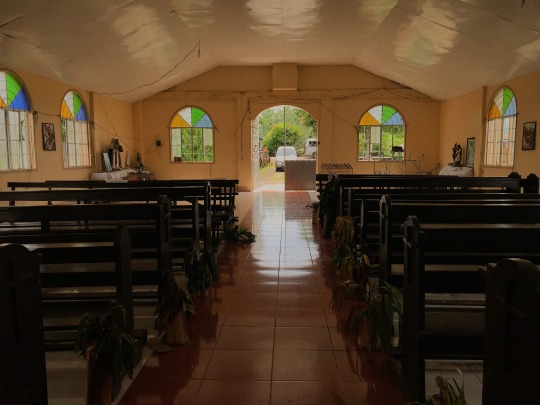
San Pedro Church, Quinapondan, Eastern Samar, 2018
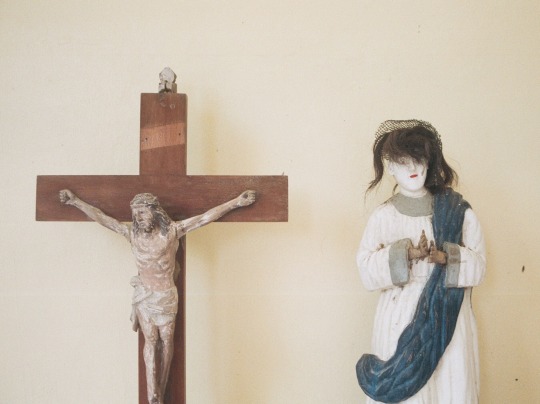
San Pedro Church, Quinapondan, Eastern Samar, 2018 | Fujicolor C200 in Canon TLb
From afar, San Pedro Church looked like a typical province church. Beautiful and small. Up close, it was of dried flowers, broken pews, shattered glass panes, and severed holy statues. I wonder how a church, that stands in the middle of a Barangay, filled with (probably) very religious people, can look so neglected. We said our prayers, and left.
CALICOAN ISLAND

Calicoan Island, Guiuan, Eastern Samar, 2018 | Fujicolor C200 in Canon TLb

Calicoan Island, Guiuan, Eastern Samar, 2018

Calicoan Island, Guiuan, Eastern Samar, 2018
The moment we arrived, it was low tide. Nevertheless, the Island was beautiful. For someone as easily fascinated as myself, I am in awe. (as usual) I don't have much to say about Calicoan, except that it makes me feel like leaving the City life for good.
Traveling with people who are from a different generation means I have to do my millennial shit alone. And so, that day, as my elders are chitchatting and trying to avoid the sun and the sea, I put on my bathing suit, went down the beach, set up my phone camera beneath the rocks, and took videos and photos of myself along the shore.
Sounds lonely, but it was refreshing.
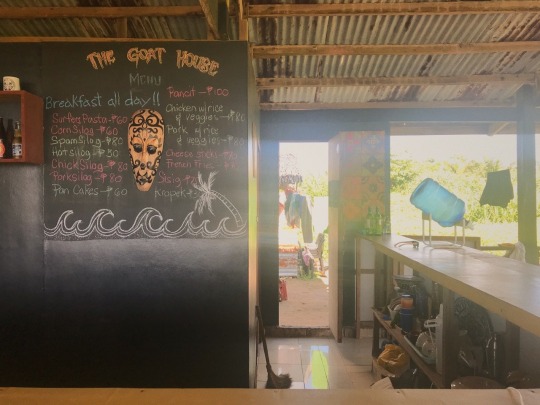
The Goat House, Calicoan Island, Guiuan, Eastern Samar, 2018
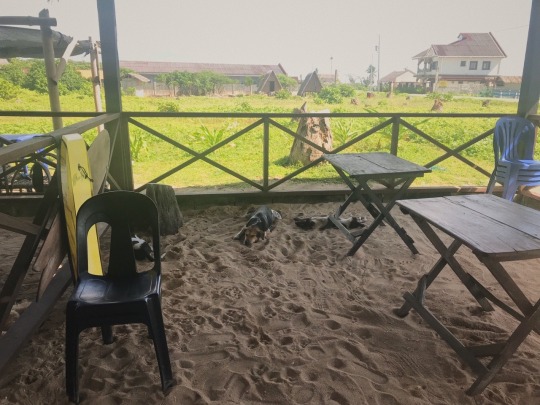
The Goat House, Calicoan Island, Guiuan, Eastern Samar, 2018

The Goat House, Calicoan Island, Guiuan, Eastern Samar, 2018
A few steps away from Calicoan Resort is a surfing spot called ABCD Beach, and across that beach is a small eating place for surfers called The Goat House. I urged my Aunt to try their food, which I had high hopes for. Not as good as I hoped, but the stories we heard inside The Goat House made up for it.
The eatery was manned by 2 locals and a French traveler, the girlfriend of one of the locals. The 32-year-old French waitress served our food, along with the story of the surfing scar on her leg--upon asking. Her travel story followed right after. She was really brave.
Another foreign traveler sits by the wooden bar. The Dutch surfer/customer enthusiastically answered my Aunt's inquiry: "So how's the Philippines?" with very lovely, positive words. It’s a shame that they might’ve experienced the Philippines more than I do. Before leaving, we finished a kakanin that one of my uncles ordered from a vendor by the road. Despite the food, I have no regrets about visiting the place.
SULANGAN

St. Anthony of Padua Parish, Sulangan, Guiuan, Eastern Samar, 2018 | Fujicolor C200 in Canon TLb

St. Anthony of Padua Parish, Sulangan, Guiuan, Eastern Samar, 2018 | Fujicolor C200 in Canon TLb
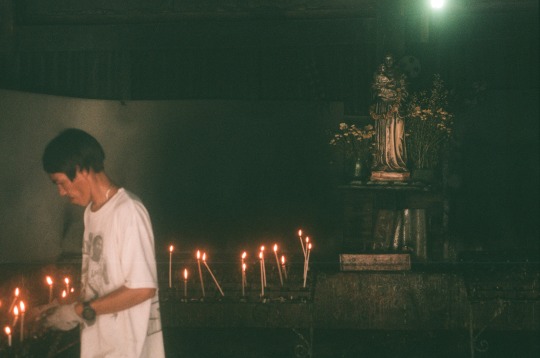
St. Anthony of Padua Parish, Sulangan, Guiuan, Eastern Samar, 2018 | Fujicolor C200 in Canon TLb
This is a corner dedicated for offering prayers to St. Anthony of Padua. As expected, it was filled with Catholic tourists lighting their candles. I waited long for the area to clear up to get a shot. However, as I finally take the long-awaited shot, a man in short bobs and worn-out gloves replaced the group of praying people. He was patiently clearing out the candle drops and leftover wax before another set light new ones. I gladly included him in the frame. Only to find out weeks later that my shot was out of focus. Even so, I enjoyed the people-watching.
SAN PEDRO, AGAIN

San Pedro, Quinapondan, Eastern Samar, 2018
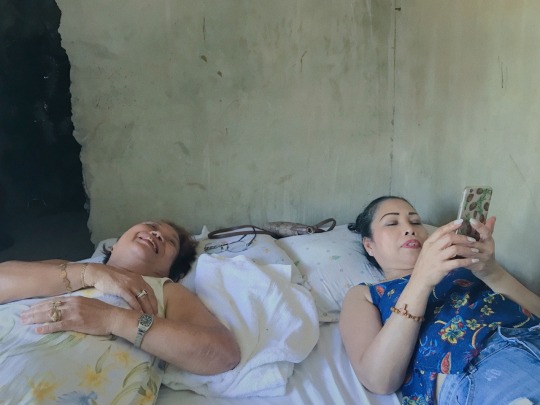
San Pedro, Quinapondan, Eastern Samar, 2018
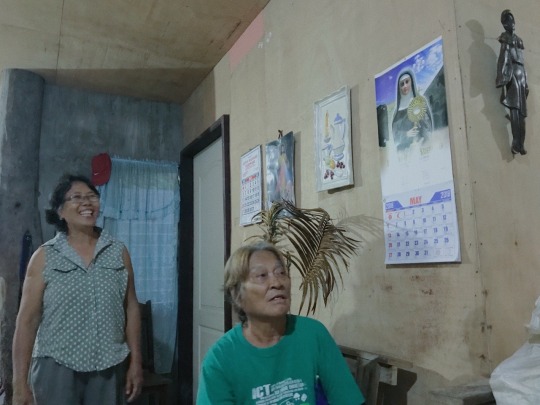
San Pedro, Quinapondan, Eastern Samar, 2018
It was a mini recap of my dad’s childhood, before finally leaving Samar. I saw the house and the woman--his aunt--who raised my dad. They told me lots of stories, and were very warm. I love old stories by old people.
While my dad was on video call, I looked around the house for the paintings that he was bragging about ever since I landed. This has to be the highlight of my trip--nothing’s more interesting, so far, than my father’s long lost art! Finding nothing, I inquired once again:
“Nasaan na raw po ‘yung mga paintings ni daddy?”
(Where are my daddy’s paintings?)
I got my answer.
“Wala na, natangay ng Yolanda.”
(None are left, they are taken away by (Typhoon) Yolanda.)
For a while there, I was devastated. I could sense my dad was too. So, I let him talk to his old friends and family. He was laughing the whole time, despite the weak signal, pixelated faces, and slurry words.
At that moment, I decided I should go back soon. I’ll be with dad. He will be coming home, too.
--‘Till next time!
3 notes
·
View notes
Text
December 20
A month of days. Yes 1 month and a bit here, and there's a pleasant routine to follow. Let's start at midnight: The night club down at the beach,perhaps 100 meters as the grackle flys, has turned up the bass trance music, earplugs are useless, the vibration rocks the air. Full fans (it's 30 degrees in the bedroom), and the rustle of the whirring blades seems to sound like hard rain on a tin roof. Rolling on my left side puts my mostly deaf ear up, so sleep is possible. The dogs have exhausted themselves barking back and forth, only the all night roosters still call false dawn. Really, after a month, it's unheard background noise.
First light comes at 6:15, and by 6:30 it's full day. The night breeze off the mountains has lowered the air temperature to 23 degrees, time to pull up a bedspread over the crisp white sheets. At 7 am the office next door opens and the hotel day begins. The office staff are charming, very helpful, and tolerant of fractured Spanish. They also are happy, and often given to bursts of laughter together. Whether it's calling taxis, explaining where to find goods(and prices), or arranging repairs,they are a nice bunch. I always try to speak Spanish, respectfull, and Leyte, office clerk, patiently corrects my errors. As I make a fruit smoothy daily, they get a glass each. Likewise for the cleaning staff, maids, all women who get excited about cake or smoothies. i realize that with their income, family expenses, and lifestyle, that things like cake or fruit are luxurys.
Up, showered, boil tea water, make breakfast and eat it while reading the news, 8 o'clock and the day awaits. The sun is well up and the land breeze fades, so the temperature quickly rises to the daily average of 30 degrees. Now it's choice time: to market? bank? beach? Whichever, first i take a neighbourhood walk, checking out the progress of the cement road paving, down to the shore to watch the big rollers crash in with a fling of frothy foam, then back up the steep hill, via one of several overgrown paths and crumbling cement stairs. The bouganvillea coats walls and raises it's multi coloured blooms above the impenetrable thorn. Coconuts cast dappled shade, and the short coarse scrub bushes are still cloaked in rainy season green.
Back at Casa Dan, it's pack a snack, water, keys, combi coins,sunhat, walking sandals, smear on a generous layer of sunscreen, and hike off to the caraterra(highway) to play chicken with the four lane speeding traffic. Pedestrians make better targets than dogs, and no one slows a bit. From a patch of shade I can watch for the distinctive blue canopied pickups, with their destinations hand painted on the front, and a hand lowered limp wave signals for a pickup. Sometimes the back is empty, sometimes there are 12 people crammed in. It's "Buenos Dias!" to all and most reply.
So..Which beach? A 5 to 10 minute ride drops me at the side of the road, and it's up to a 20 minute walk down to the sand. It's nice to find some shade, and quickly dive in the cool green water. Yes.. cool.. The ocean currents have changed this week and the soupy sea now has a nip to it, perhaps 25 degrees. Still feels awfully good after a hot walk. Beach time is about 2 to 3 hours, drink a coconut, slurp cold water, then well air dried, walk back out to the homebound combi.
Home for lunch, guacamole, or fruit,maybe a cinnamon bun from the uptown bakery, then a siesta, Full on fan, dark room, earplugs to dampen the office chatter, roll out on the crisp sheets on the comfy bed..zzzz.
Up at 3to go to the pool, bringing a good book, and choosing a shaded lounger. Usually there is some other long stay guest, and we chit chat about peoples health, world news, or just a lazy philosophical thankfulness for being here. The pool is 25 degrees, so it's refreshing, crystal clear, lap pool, so it's only 4 feet deep by 50 feet long by 12 feet wide. Some folks do laps, most just float about doing water exercises. By 5 oclock everyone has gone back to their rooms, preparing to go out for dinner, or like me prepping a meal.
At about 6, a few regulars gather on the 3 story rooftop to watch the sun go down. Now is when the news of the day gets exchanged, with tips on good restaurants, better food shops, who's coming or leaving, and a sort of check in. Nice to feel part of a group, though we could hardly be more varied, from hippies(me) to Airforce. Everyone is retired, mostly Canadians, and compatible. The sun reliably sets at 6:15 in either a bulging orb slipping into the sea, or into a mist bank split by the red rays,backlighting the wispy clouds and casting red/orange rays across the sky. Night falls quickly, and by 6;30 everyone has hasta manana'd.
A fine dinner for me, usually chicken fish or shrimp, with peppers, onions and garlic, sometimes rice,or potatoes, and lately alfalfa sprouts made in my sink. The night mosquitoes are active, so it's into the well screened room to watch netflics till 9, then zzz till the disco starts up again. If all this sounds lazy and relaxing, it is. Hasta Luego!
0 notes
Text
Mark & Georgia’s 2018 Philippines Trip
Here we go again, another trip, another blog. For those of you familiar with our recent Road Trip blog this will be of a different sort because it’s going to be a different sort of trip, a mix of business and pleasure. We’ll be based at Georgia’s mom’s house in Manila, making a series of short trips here and there over the next month. Hopefully it will result in some interesting thoughts and photos.
Day 1: Graeagle to Sunnyvale to San Jose to SFO
Seems like I was driving all day, although it was a pleasant drive until I got close to the Bay Area into all the traffic. I’ve really gotten used to the “traffic” in Graeagle, where it’s unusual to see more than 3 cars in town. At Georgia’s suggestion I drove straight to EBR for a visit with my old colleagues and to check up on how things are going there. Quite well it seems, with a number of development projects underway, what we engineers like. But everyone seems to be really stressed with all the clinical and regulatory related tasks on their plates now. That’s what I knew would be coming with the US clinical trial, and I’m even more certain I picked the right time to retire.
Took an hour in that lovely traffic to drive from EBR to Georgia’s sister Dinah’s house (all of 12-13 miles) and another hour to drive to SJC and back for Georgia to return her rental car (she had flown there last week). An hour to pack Georgia’s stuff and back on the road to SFO. In our Road Trip blog it was noted that Georgia has trouble packing light and this trip is no exception.
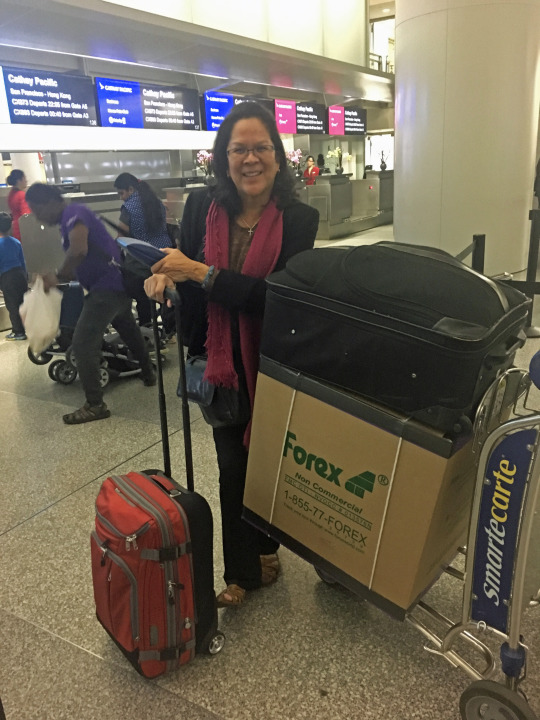
The box weights 69.5 pounds (carefully titrated as the airline limit is 70), the black suitcase is about 55 pounds, the red carry-on is acceptably light. Not shown is a backpack. Yes she has problems packing light. OK, to give her a break, since we’ll be in Manila on Thanksgiving, the box contains a frozen turkey, ham, and all the fixings for a proper Thanksgiving dinner, things that you can’t get in the Philippines. Plus a LOT of other goodies for her mom, our snorkel gear, etc.. She got her standby cleared quickly, got her ‘luggage’ checked with a few stares from the baggage handlers, and was soon off to her flight to Hong Kong.
With my flight to Tokyo in the morning, I overnighted at an inexpensive motel near SFO, one that turned out to be unexpectedly nice. At least I wasn’t itching in the morning.
In case you don’t know, in the interest of national security we don’t fly together. That’s not really it… Georgia flies Cathay Pacific since she gets family privileges from her sister Vinee, a CP flight attendant. Georgia pays a ridiculously low fare for business class. I fly United since I spent so much time with my butt in their seats for business travel I can buy the cheapest economy fare and use my miles to upgrade.
Day 2: SFO to Hong Kong (Georgia) and Tokyo (Mark)
Both of us had very bumpy flights, on mine the seat belt sign was on most of the time, and the flight attendants were told to buckle up multiple times. Didn’t stop me from eating and drinking my way across the Pacific though; I arrived in Tokyo fully stuffed. Georgia reports the same on arrival to HK.
Flying in the front of the plane is the only way to go; I fear the day when my miles run out. Georgia may have to take a job with an airline so I can get family privileges. Anyway, she’s continuing on to Manila this afternoon while I’m overnighting in Tokyo at another airport hotel and flying on to Manila tomorrow morning. The flight with a 19-hour layover is a lot cheaper than one with a short connection, saving much more than the cost of a hotel. That’s a good enough reason but I admit to being a travel wuss, I like having this break to get cleaned up and rested. No reason to hurry!
Day 3: Tokyo to Manila
Easy travel day to Manila for Mark; couldn’t sleep so got up early and went to the airport (a 2 min walk from my hotel) and had breakfast at the nice ANA lounge. Smooth flight to Manila but with the usual holding pattern on arrival. I’ve never flown into that airport without doing at least a few circles. I think the airport planners are the same people who planned the traffic control in Manila.
Speaking of Manila traffic, shortly after I arrived we needed to drive Georgia’s mom to meet with the family attorney to have some documents notarized. Off we went to Alabang, one of Manila’s districts, with Mark driving and only a vague idea of where we were going… after many calls to the attorney we finally decided we’d never find the meeting spot and just parked and told him where we were. He knew the area well and was able to find us. By the time we headed back home it was dark, which makes driving in Manila even more terrifying. People all over the place, motorcycles, trikes, and jeepneys pulling in and out and stopping wherever and whenever. Feels like you’re inside a video game. Luckily we got home before we ran out of lives; Mark quickly headed to the fridge to grab a much-needed San Mig.
Sorry for not having more pictures, but there havn’t been many photo opportunities up to this point. Things will pick up in a day or two.
Day 4: Manila to Tacloban
A couple errands this morning then back to the house to pack our bags for a 3-night trip (nice light luggage this time!) then to the airport for a quick flight to Tacloban on Leyte island. A couple days of business to conduct here and in Catbalogan on the nearby island of Samar. You probably remember Tacloban from the 2013 super-typhoon Haiyan (Yolanda in the Philippines). Tacloban was the center of devastation from this storm. The city was all but destroyed; nearly 6000 perished in this city alone. Flying in we could see one of the reasons the storm wreaked such havoc – the city and territory surrounding it are very level and low-lying, stretching flat many miles until the mountains are reached. Besides the winds which removed nearly every roof in the city, storm surges of up to 20 feet did the most damage, including completely leveling the airport we flew into. We didn’t know what to expect, but were pleased to see a strongly recovering city and meet a few people whose strength, determination, and pride are readily apparent. There are still a few reminders of the storm, we saw 4 or 5 abandoned, gutted, roofless buildings, but almost all traces are gone and the city has been rebuilt, at least on the roads we passed.
In a striking contrast to Manila, traffic here is very civilized. Our taxi driver actually stopped and let another car enter a roundabout before him! To regress a bit and explain Manila traffic, in the US we drive (most of us at least) by the lines on the road and by rules where for every situation the right of way is defined. Right of way in Manila is determined by which car can squeeze a millimeter in front of the other. Georgia has remarked that it’s a great waste by the government painting lines on the roads as no attention whatsoever is paid to the lines, the number of lanes being defined by the number of cars, trucks, and motorcycles that can possibly squeeze side to side within, and often beyond, the edges of the roadway. It can seem like total chaos, but carnage and catastrophic accidents are minimal as traffic speeds using these principles are generally reduced to a crawl. Vendors in flipflops can walk in between and around cars without fear of being run over as they can move faster than the cars can. It surprisingly works as long as you’re in no hurry to get somewhere.
A side note... if you like a glass of wine or two, finding it can be challenging as the Philippines is not at all a wine-drinking nation. Interestingly enough, grape cultivation and winemaking were brought to California by the Spanish Catholic priests and followed the path of the missions. Yet with 300 years of Philippine colonization by the Spanish, grape growing appears to have been unsuccessful here and wine can be difficult to find.
Normally we don’t worry about it and settle for a cold San Miguel. This evening Georgia was craving a glass before dinner so we asked at the hotel desk where we could find a bar or restaurant that could help us get a fix, and we were pointed to a place across the street. Georgia was excited when the menu had a small wine list, including two Cabernets and a Merlot. She asked for one of the Cabernets; the waitress said she had to go check if they had it. She came back shortly and apologized, saying they were out of that wine. Georgia asked for the other Cabernet. Sorry we’re out of that one too. OK, what about the Merlot? Sorry ma’am, we’re out of the Merlot too. Do you have any wines? No ma’am, we’re out of all wines. Amusing to us at least as this is a recurring story – we’ve even seen nice restaurants in large hotels in Manila, with impressive wine lists, unable to produce anything but a Barefoot Bynum red. Maybe Georgia goes to work for an airline, and Mark starts a wine import business. We finally got a lead for a nice Italian restaurant, which had a good selection of Italian wines. An excellent dinner and Georgia finally got her wine! Another thing you wouldn’t expect here is great Italian food – we both feel that we’ve found some of the best outside of Italy, in restaurants started by Italian ex-pats who have been captured by Filipina wives (or vice-versa)! I can understand that. 😊
Day 5: Tacloban to Catbalogan
This morning’s business was a meeting with the local head of the Philippines Land Bank. This is a government-chartered organization obtaining land and re-selling to farmers. The income from the farmer’s loans funds the acquisition of property. The subject transactions here are about 165 hectares (400+ acres) of family-owned property in Catbalogan, much of which has been settled on by squatters/farmers. This is the type of land the Land Bank is trying to get, to officially distribute to the squatters and make them legal taxpayers. The family has been trying for many years to deed the property over and receive payment. Many frustrating years, always being told that this document or the other is needed; when that’s produced there’s always another. And then the next time they go back, the official they were working with isn’t there any more and no one has any recollection of previous actions.
The meeting went well, it seems that the government is making an effort to centralize and simplify these things, for example going forward this can be handled through the office in Manila rather than having to travel to Tacloban. According to the official very little is left to do before this can be completed. Georgia warns that we shouldn’t count on this assurance yet.
Now we’re tourists for the afternoon – our driver picks us up from the Land Bank and we head towards Catbalogan. We’d hired a driver and car for the day to take us around on our errands and then deliver us to Catbalogan, about 110 km from Tacloban. On the way he drove us through one of the areas hardest hit by the typhoon, a low-lying seaside area of shanty homes. You may remember seeing post-typhoon pictures of a large freighter sitting on land quite a way from the water – rather than removing the whole thing they left it in place, some 300 meters from the water, built some structure around it and turned it into a memorial for the Typhoon victims. Strange to see a freighter in the neighborhood but a fitting tribute.
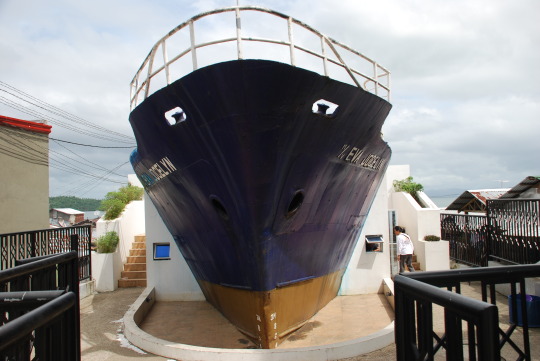
The disturbing part of it though is the neighborhood. The whole area was completely swept bare, but it’s been rebuilt as it was, with poorly constructed shacks of wood and tin. That’s how the people lived before, and what they know, but it’s a shame that the government didn’t help relocate them or at least build more substantial homes.
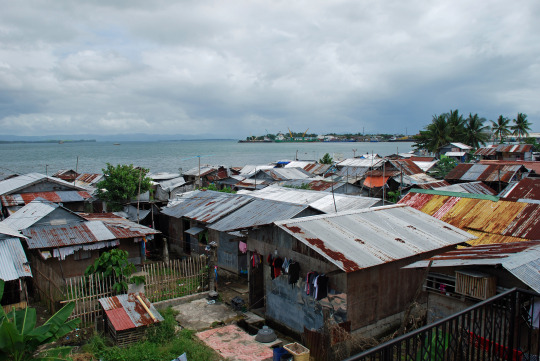
We drive over the San Juanico bridge which links Leyte and Samar islands, the longest bridge in the Philippines, built during the Marcos regime. Current president Duterte plans to build a longer one (mine’s longer than yours!) linking Luzon to Visayas but it hasn’t been built yet. Following the bridge is a winding 2-hour drive up the mountains and back down into Catbalogan.
Catbalogan is a city “in the provinces”. I’d heard that term before but wasn’t sure what Filipinos were referring to – the meaning is similar but more polite sounding than our euphemism “out in the boonies”. It’s a busy city, but very remote and without many of the amenities you find in the larger cities. We’re booked at the most expensive hotel in town: a “deluxe triple room” with private bath is $34/night. The room is cozy with a double and a single bed and not much space to move around, but the hotel is spotlessly clean, due we think to the army of OJT (on-job-training) helpers from a local high school. At least 20 of these always-smiling faces are constantly cleaning and re-cleaning, each one stopping to give us a warm greeting whenever we appear, coming or going.
To me, Catbalogan is the “city of trikes”. Manila has a lot of trikes, but this city is totally clogged with them, and they’re all in (slow) motion all the time. Both motor- and human-powered, passenger trikes and delivery, they’re everywhere. Colorful, each has been customized by its owner, with the owner’s name and often a favorite bible verse or a personal testament to the glory of God emblazoned on front or back. Some busses and delivery trucks are also on the streets, but few private cars. Why would you need one? A noisy and bumpy ride on a motor trike costs 8 pesos (about 15 cents) to take you anywhere in the city. The pedal trikes are the economy ride, only 7 pesos. We go first class!
You can play a quick video of a trike ride in Catbalogan here:
https://photos.app.goo.gl/3SMSh43GFNhmnvf79
Day 6: Catbalogan
Business day #2 with visits to the Registry of Deeds (task is to get the deed to the property annotated with the names of the new settlers), then to the Department of Agrarian Reform (task unknown). Conference with Georgia’s sister in the US and back to the DAR to ask for a map of the new property division. Both the ROD and DAR have promised to have the documents ready tomorrow morning so back we’ll go.
While here in Catbalogan we’ve been “taken care of” by a family that is linked to Georgia’s by a long friendship. Third-generation daughter Bayan has been helpful getting us to the various appointments; today we met Lola (grandmother) Noling, the family matriarch, at her electronics and appliance store she’s been running for 65 years. She’s 87 and going strong, no hurry to retire. We were chatting in the store and asked if they knew a place that had good Tomalos – a Filipino take on the tamale with rice “masa” around a pork filling, coated with peanut butter, then wrapped in banana leaf and steamed. With typical Filipino hospitality, it seemed only minutes before table and chairs were pulled out and Tamalos and Lumpia appeared for us to try. Different, delicious, and RICH! Georgia and I couldn’t quite finish a whole one. And also in true Filipino fashion just as we were putting our forks down we were asked what we’d like for lunch. Oh jeez, didn’t we just finish lunch? Lola Noling definitely wanted to take us out so we agreed to dinner, we’ll meet her at the store around closing time.
Dinner was at a nice restaurant right on the harbor, with Lola Noling, daughter Collette (Bayan’s mom), two of her sons Bong and Jun, Bayan, and a few more family members. A feast of delicious food, more than enough beer, hilarious conversation with her sons trying to speak English and me trying to understand Taglish – it was one of those amazing times that leaves you with a smile, a warm heart, and a new family.

Day 7: Catbalogan to Tacloban to Manila
Georgia thinks I’m writing too much. Maybe I’m trying to find things to write about in the absence of any real interesting travel. I’ll keep it short today.
Two more appointments this morning. First back at the DAR to pick up maps of the property. This visit was successful. Then an appointment at the Registry of Deeds to meet with the registrar whom Georgia had an appointment with yesterday but she wasn’t in the office. She was most helpful (not) explaining the number of documents that still needed to be completed and 2 new cities we would have to visit to get this done. One step forward, 2 back.
We took a shared ride van back to Tacloban, through rain most of the way. The highlight of the day was a 30 minute trike ride from the van terminal to the airport, in the rain. Remember, these things don’t have doors – Mark held an umbrella out as a door/windshield and managed to stay pretty dry. His luggage tied to the back of the trike didn’t fare quite as well.
Day 8: Manila to Nasugbu
Finally! Today we made the 2 ½ hour drive from Manila to Nasugbu, the location of Kawayan Cove and our house-to-be. This is the third time we’ve made this drive ourselves (no driver) and it’s starting to seem familiar, at least when we get out of Manila and onto the Cavite Expressway heading south. Today I got very much the same feeling as when I drive from the Bay Area to Graeagle, with lots of traffic and the associated stress until we reach Auburn, about halfway there. After that it’s an enjoyable drive through the mountains and pine forests the rest of the way. This was very similar – through Manila, Cavite, all the way to Naic it’s a lot of traffic and those ever-annoying trikes. Past Naic you enter the mountains, tropical jungle rather than pine trees, and all the traffic, trikes, and stress disappear. Finally we get our first view of the Batangas coast, and get that peaceful feeling that we’re getting close to home.
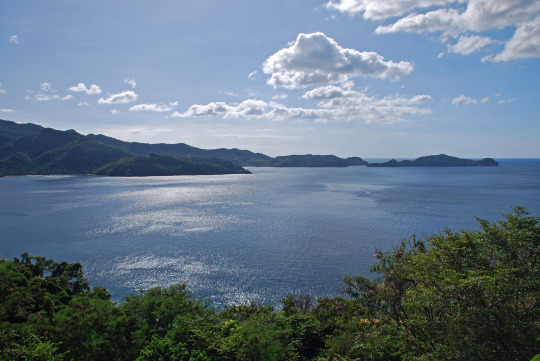
We’re staying for three nights at Punta Fuego, a members-only golf and residential club just up the coast from Kawayan Cove. Luckily one of Georgia’s brother-in-law’s parents are members here and can make reservations for us at one of the club’s guest “casitas”.

Lovely place with a lot of different beaches and nice amenities – we looked at properties here but as this is one of the older developments along this coast all of the better lots are already taken, and we had our hearts set on an ocean view. Not to mention the prices, and the monthly dues, and all that…
Tomorrow we get to see our house for the first time!
1 note
·
View note